insights
Covenanting Statement 30 th Anniversary

Covenanting Statement 30 th Anniversary
LeavingJesuswhite the behind
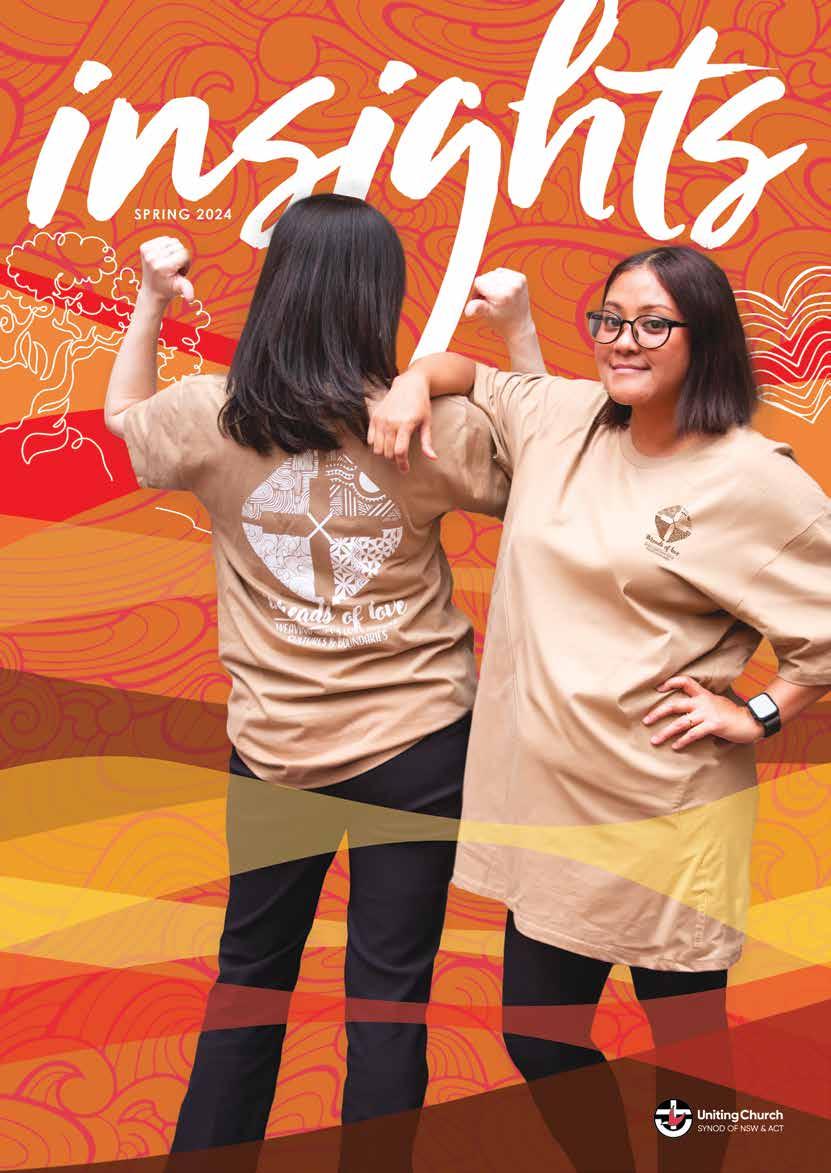
17TH

It’s easy to get started No upfront cost No term contracts
Vennu is an easy to use platform with:
• Enquiry and booking tracking.
• Online payments.
• Money paid directly into your nominated bank account.
• Listings with photos and all the details people want to know.
• Availability calendar.
• Digital marketing campaigns and resources.
• Support available 7 days a week.
“Working with the Vennu platform has enabled us to offer our various spaces to a wider audience and including the link to Vennu on our website has also made hiring the spaces an easy option.”
Janet Brentnall, Booking Officer Berry Uniting Church
Vennu is a new way to promote. Turn idle capacity into revenue. Increase bookings. Engage with new customers.
Enhance community connection. Bring life into previously underutilised spaces
Reduce time spent on calls and administration.


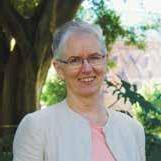
REV. JANE FRY GENERAL SECRETARY
THE GENERAL SECRETARY IS APPOINTED BY THE SYNOD TO PROVIDE LEADERSHIP TO THE CHURCH BY ACTIVELY ENGAGING IN STRATEGIC THINKING ABOUT THE LIFE, DIRECTION, VISION AND MISSION OF THE CHURCH.
At the recent Discernment Summit, I shared an icon with the participants. It’s an image of St Hilda, founded and first abbess of the monastery of Whitby and one of the convenors of the Synod of Whitby in 664.
The main item on the agenda of that Synod meeting was to resolve the date of Easter which Celtic and Roman Christians celebrated on different days. It’s fair to say that outcomes from the Synod of Whitby shaped the church in the British Isles and beyond. Although having been born near Whitby in Yorkshire, I would quite like to claim Hilda as an ancestor, I can’t quite do that, I did adopt St Hilda as the patron saint of my term as General Secretary. The woman with a shepherd’s crook in one hand and the church cradled in her other arm has always struck me as a profound and important image. It is particularly pertinent to our own times.
It's important to me as a reminder that the church is not a problem to be solved and it’s certainly not our problem to solve in any case. The church is a gift to be gratefully received and lovingly cherished. Sometimes, in the face of change and disruption, both within and without the church, it’s very easy, very tempting, to forget that and apply our energies instead to problems that we think are manageable and within the compass of our own limited imaginations. It’s also easy to reach for the tools of the secular corporate world to address the problems we think we have or to justify our own preconceived solutions to those problems.

remember that we are all God’s creatures gathered together for God’s purposes, purposes which encompass nothing less than the transformation of the world.

In the realisation of God’s infinitely compassionate forgiveness, we can again open our ears to the Word and re-orient ourselves towards God’s vision. It’s very clear that that first Summit set the scene for all those that followed and enabled Presbytery and Synod leaders to work together differently. It has led to renewed relationships, a deeper understanding of the importance of ‘inter-conciliar’ in UCA polity, a transparent sharing of information and agreement about shared challenges. Is everything now perfect? Of course not – we are all still very ordinary humans.
THE CHURCH IS A GIFT TO BE GRATEFULLY RECEIVED AND LOVINGLY CHERISHED
There has been lots of talk, lots of reflection and, thankfully, we appear to have moved beyond ‘consultation’ (a weasel word if ever there was one!) into genuine collaboration. We labour together because we treasure the church and are committed to sharing that gift with the world. As I said to the Summiteers at the last gathering, I feel quite fizzy when I think about the journey that we’ve been on together – it can only be the work of the transforming Spirit!
The Summit journey that we’ve taken together over the last two years has enabled a very different perspective on the life of the church in this Synod. The journey began in 2023 when the ex-Moderator, Rev. Simon Hansford, convened a meeting of Synod and Presbytery leaders to consider the wellbeing of the church in this Synod. That meeting began with lament and confession – a mutual recognition and acknowledgement that we had "not done what we ought to have done, and done what we ought not to have done".
It’s hard to over-estimate how important this was and is for all of us – to relinquish all of our firmly held, correct opinions, to surrender our pet theories and our pat wisdom and to
This blessing is attributed to Hilda of Whitby. While I think the provenance is unlikely, the words capture the spirit of hopeful joy and purpose that I see reflected in the icon:
Trade with the gifts God has given you.
Bend your minds to holy learning that you may escape the fretting moth of littleness of mind that would wear out your souls.
Brace your wills to action that they may not be the spoil of weak desires.
Train your hearts and lips to song which gives courage to the soul.
Being buffeted by trials, learn to laugh. Being reproved, give thanks.
Having failed, determine to succeed.
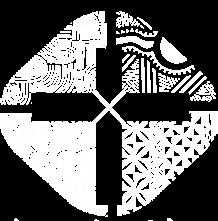



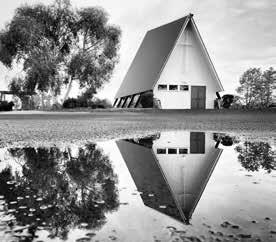



As I approach a year in the role as Moderator, I’ve been reflecting on how blessed I am to have been given the opportunity to serve the Church. To witness the Holy Spirit in action, transforming communities, and delivering hope across the Synod.
It has been especially an honour to support the advocacy work of Uniting NSW ACT. The passion, determination and fervour that our Uniting colleagues bring to their roles is contagious, and it is evident that it is so much more than a job for them. They thirst for, and relish in, the pursuit of justice, which rings true to the call of the Gospel ‘to do justice, and to love kindness, and to walk humbly with God’.
I have voiced the need for urgent drug reform in our state. Specifically, the need for our leaders to start listening to experts in the field on how we can best help those who are impacted by drugs in a productive and informed manner, rather than inflicting counterproductive and punitive measures.
stand alone. It is complex, multifaceted, and intersects with other problems, such as mental health, homelessness, domestic violence, unemployment, and poverty. It was an incredible achievement by the team to help secure a NSW government-led drug summit.
In this role, I have also lent my voice to sounding the alarm for climate change. As a daughter of the Pacific, I know what’s at stake if we don’t address this climate crisis urgently. We are seeing in real time, the unfolding impacts of the climate crisis, not only for our communities here in Australia, but for the people of the Pacific, whose livelihoods, homes, and culture are under immediate threat.
Having been a leader of faith in many different communities, I have seen first-hand the impact of drug dependency on individuals and their families. I understand that this issue does not
These are the communities that contribute the least to this issue, but will be harmed first, hardest, and longest by climate change. This issue remains one of the most important social and moral challenges in human history and we have no time to lose.
As we fight the good fight and tackle these sometimes overwhelming and complex social issues, it’s easy to forget the real and life-changing impact that our work has on individuals. On the parents of a drugdependent child, on the families whose homes are seeping into the ocean shallows, and to the children living in out of home care. We must take time to reflect, recharge, and recognise our achievements.
As we move towards 2025, I look forward to continuing to work collaboratively with the Uniting team as we walk purposefully towards a society of justice, kindness, and compassion.
Follow the Moderator on instagram:
instagram.com/moderator_ucanswact
IN RESPONSE TO “CHURCH TRADITIONS AND CREEDS”
The UCA Basis of Union also “commits UCA ministers and instructors “to careful study of these creeds and to the discipline of interpreting their teaching in a later age”. That’s far more than just standing and reciting them off rote; much more than quoting them as the touchstone of orthodoxy (which, despite McCaughey’s words, some still,do); it is the hard work of understanding meaning, bringing to life and contextualising for the present, living within the ambiguities and richness of the phrases used, and also attending to the large gaps in between those phrases where much more needs to be explored.
JOHN SQUIRES
IN RESPONSE TO
“AUTHENTIC CONNECTIONS WILL ENSURE A VIBRANT FUTURE”
Good news for young people to strive now and the future. I’m interested in young people ministry and had served young people for over 55 years in Papua New Guinea, Solomon Islands and Fiji in the field of evangelism training to reach other young people to bring them into the Church. I would very much appreciate if we have a dialogue to discuss further.
PASTOR ARIA HEGAME
IN RESPONSE TO “FREEING THE LORD’S SUPPER FOR
Like Christine in her comment, I wish to endorse the emphasis that the Rev Dr Karyl Davison places on the importance of the Eucharist as an instrument of Mission. St Augustine wrote about the Eucharist in these words “Behold who you are; Become what you receive.” Is it because of our adoption of a great familiarity with the observance of the Lord’s Supper that we have lost some of the mystery, and its potential as an outreach of Mission? We need to grasp the potential it offers to reach out to those seeking a meaning in their lives. Thanks, Karyl, for your inspiration.
DOUG HEWITT
I came to Faith through Eucharist, a little like Sara Miles in her book Take this Bread.
Took, blessed, broke, gave, as Jesus did at the Last Supper and at the post Resurrection Meal at Emmaus, is classic Mission that goes beyond needing to understand language. For 20 years, I celebrated Eucharist with people who were addicts, developmentally delayed, mentally very unwell, dementing. To take, bless broke and give to people who were often illiterate, was very welcomed. They knew that Christ was present. So, thank you Rev Dr Karyl Davison, for showing us, again that Eucharist is Missionwhere all are welcome. I hope that you are able to encourage others.
CHRISTINE SHEPPARD
“THAT’S
A wonderful ministry between Rev. Alofa and the beautiful congregation of Wingham Uniting Church. They have bent over backwards to do whatever they can to make the workers welcome, meet their needs, and offer a space and a service for their worship. It has been a blessing to the whole Wingham community.
DI RAYSON
This is really encouraging to hear of our Chaplaincy service to those who are new arrivals with very little understanding of the context in Australia they will be living in and for Rev. Lofa as a person of diaspora to share her skills and experience with her Pasifika is an act of the Love of Christ in action alone even if it just means sharing a meal with them.
Malo e ngaue moe mateaki e ngaue a Sisu Kalaise kihono Siasi.
ASINATE

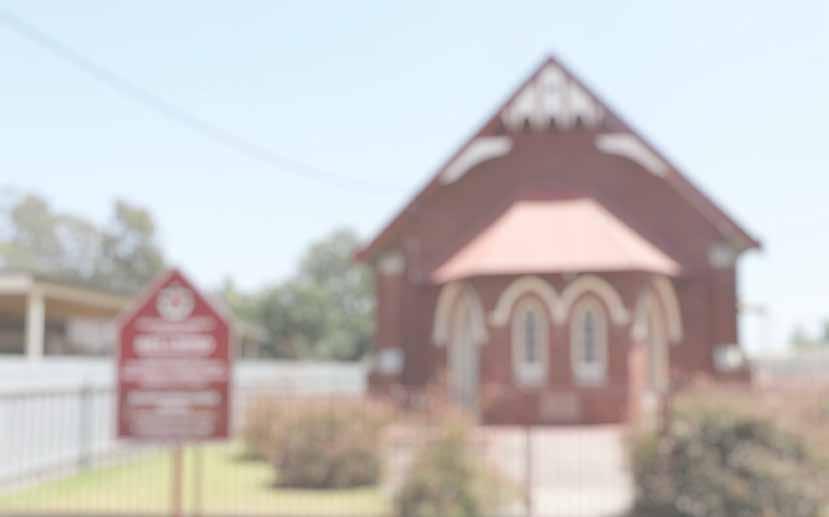
Cessnock Bellbird Uniting Church’s Bellbird Church and hall has been unused as a worship centre since 2016. Since then, it has been used for a permanent monthly garage sale and storage space. Recently, the congregation started planning something new.
Cessnock Uniting Church Council Secretary Anne Hawkins told Insights that the congregation now has plans for a new ministry centered on families and young people.
“We will also have special occasions such as Teddy Bears picnic (we give teddies to all our baptismal children); Thanksgiving for our kids; Pets Blessing; Dinner Church; church around the fire pit and whatever other ideas we can enthuse the community to become involved with.”
“The property is flat and fully fenced, so it is great for kids. The yard and the buildings are all fully accessible,” she said.
“We will start Cubby Club (our playgroup) at the beginning of Term Three (23 to 24 July) – on Tuesdays from 10am to 12pm during school terms.”
“Messy Church will start on the first Friday of each month, between 4-6pm, beginning in September. We will be offering craft and fun activities, then church, followed by food, all based around a theme ‘Creation’ for September.”
Cessnock Uniting Church is the recipient of a Synod Missional Grant, which Ms Hawkins said would help prepare the church, hall, and garden to be able to deliver worship and other services. This includes sound and music via a new sound system and speakers, a smart TV, and a computer.
“There’s currently no internet, so the grant will establish this connectivity,” Ms Hawkins said.
“Our new gardening team are now able to landscape the bare grounds to suit these outdoor missional opportunities. We hope one day to be able to market the beautiful heritage listed church as an intimate spiritual wedding venue and attractive historical backdrop for photos.”
“We look forward to offering an original faithful worship space, invigorated for refreshed expressions of church,
playgroup, and community gatherings, that is both visually attractive, and up to date in IT, hospitality and presence.”
“The Bellbird community is growing quickly, as families and early retirees build new homes around us. We are conveniently situated on the main road, though still enjoying the song of Bellbirds.”
“This gift has further encouraged and enthused the congregation to move forward. We are very grateful for Synod recognising and supporting the missional opportunities in regional areas through this Missional grant,” Ms Hawkins said.
“Synod, Presbytery, and congregations are together ‘putting our money where our mouth is’ – in other words, we are demonstrating the love of God in a practical and realistic way.”
JONATHAN FOYE



Brunswick Valley Uniting Church is aiming to grow their church younger, with a new Messy Church service.
The congregation received a Missional Grant to support the service, which is part of its current strategic planning process.
Secretary to the Church Council Carole Tansley told Insights that Brunswick Valley aims to address a gap in its services.
“We identified a gap in providing mission and worship activities across generations,” Dr Tansley said.
“Our worship congregation consists mainly of individuals over 70 years old, and while our missions—Food Box, Op Shop, and Playtime for Mums and carers with their tots—cover different generations and provide pastoral care and service, they do not include focused discipleship,” she said.
“The Playtime group for babies, toddlers, and carers is a long-standing, successful missional activity, attracting up to 40 carers and children every week during term-time for the last 25 years.”
“However, once the children leave to join school, we had no programs to continue our relationship with them. We are concerned that they may not experience any form of church at all.”
“As part of our strategic planning process, we decided to focus on this intergenerational gap to ensure that current families, particularly older children, are provided with discipleship opportunities. Messy Church is an innovative approach to Christian worship and community outreach, offering an alternative form of church for those who may not feel comfortable attending traditional services. It typically involves crafts, games, activities, and a meal or snack, all centred around a specific theme or biblical story, appealing to families with children by providing a relaxed and interactive environment.”
Messy Church gatherings will take place in the congregation’s Mullumbimby hall and church, outside regular Sunday worship times.
Services will be designed to be accessible to people from all walks of life, including those with no prior church experience. The service will allow four year-old Playtime leavers to transition to the next stage of their Christian



development and enable older siblings to join in church activities.
“We have previous experience running a successful Messy Church pre-COVID in partnership with, and sited at, the local Anglican Church,” Dr Tansley said.
“Although we have the experience, we currently lack the resources to operate a comprehensive Messy Church that aligns with our church’s growth strategy and we are keen to hold such sessions in our own church.”
The Synod grant from the Growth Funds will help the congregation purchase resources. This includes supplies for activities like: art and craft materials, supplies for games and interactive activities, and resources for Godly Play.
“We also need technology for playing videos in the hall, resources for volunteers to plan and facilitate activities, prepare food, and clean
up the venue, as well as theme and curriculum resources, food and refreshments, and marketing materials for promotion and outreach,” Dr Tansley said.
“We have just received the funds and are excited to run our first ‘taster’ on 10 July as a holiday club with a Messy Church focus. Our team comprises Rev. Tay Lee, our Minister, his wife, Woni Lee, Tania Hudson, Winifred Bower, and kitchen staff volunteers Beryl Pepper, Lalita Lyn, and Sally Tansley. We are thrilled about this new intergenerational, fun venture as we move into an exciting new era for our Mullumbimby church in Brunswick Valley.”
“We are deeply grateful for the support and encouragement from Synod and our Regional Partnership (Presbytery). This grant not only provides the necessary resources but also reinforces our mission to serve the community in
innovative and meaningful ways. We believe that Messy Church will be a transformative addition to our church’s activities, helping us to fulfil our vision of a vibrant, intergenerational faith community. We are inviting everyone to join us on this exciting journey and experience the joy and fellowship of Messy Church.”
HELPING US TO FULFIL OUR VISION
Messy Church is service for families who may not find other forms of church appealing and who don’t yet belong to a church. It is typically held once a month and includes hands-on creative experiences. It began in the United Kingdom in 2004 and has since become popular elsewhere.
JONATHAN FOYE

“In the addictions space, the wisdom is that connection is vital to recovery, so this is the focus of all our programs.”
On Sunday, 23 June, Julie Fry, Bathurst Uniting Support Services (BUSS) Coordinator, received the Paul Harris Fellow Award from the Rotary Club of Bathurst-Daybreak. Ms Fry, however, was keen to stress that the award was not just for her, telling Insights, “This award isn’t really about me but honours the hard work done by so many volunteers who make BUSS the fantastic organisation that it is today.
“I am just the face of the wonderful work they do,” Ms Fry said.
A program of Bathurst Uniting Church, Bathurst Uniting Support Services (BUSS) started in 2018 as a homeless shelter.
“It was no little thing for the Bathurst Uniting Church congregation to start a homeless shelter in 2018 and it took a lot of faith and courage,” Ms Fry recalled.
Despite briefly closing during the COVID-19 pandemic, BUSS operates programs and the weekend BUSS Café for people who are homeless, poor, and socially isolated.
“Our aim is to improve the lives of our participants; helping them to make connections to community and each other and assisting and supporting them to make better and more informed, responsible choices,” Ms Fry said.
“We have been delighted to see results in the lives of some of our people who become very engaged, then step up to run programs, teach others and give back. Our Cafe Cooking days are a great example of this. The best of those who come to the Frypan Warriors program are invited to Cafe Cooking days once a month, to make meals for the weekend soup kitchen, the BUSS Cafe.”
“Since 2018 we have grown steadily and now have programs almost every day.”
“Due to a small grant from the Office of Responsible Gambling we are now able to employ an Assistant Coordinator 15 hours per week which has eased the burden on the organising volunteers.”
“This year particularly we have seen a significant increase in the numbers of those attending. Most of our programs have seen a 50 percent increase in those attending, especially those that provide food or teach people to cook.”
“We have not forgotten our concern for those experiencing homelessness. The Housing situation in Bathurst is extremely dire (as it is elsewhere) and there is just no affordable housing available, so we are giving out about
one camping kit a week to those who are sleeping rough.”
“It’s not a great solution for people, especially as most of the winter our overnight temperatures are well below zero. We have a shower that is open every day with towels and toiletries, and we provide laundry vouchers if needed.”
For more information on Bathurst Uniting Support Services, visit their Facebook page: facebook.com/BathurstBUSS WE HAVE GROWN STEADILY AND NOW HAVE PROGRAMS ALMOST EVERY DAY
“We are very blessed that the town of Bathurst has given us fantastic support since the beginning and we have over 60 volunteers helping to run the programs and wonderful donations from many of the service clubs in the town.”
“Over the last five years the Congregation have not wavered in their support for BUSS and all those that are helped by the program.”
“Many of the congregational members are very involved with cooking meals, volunteering with programs, praying for us and making financial donations. I believe a program like this is so much stronger because it is part of a congregational response to needs in our community, and it remains a significant part of our church mission.”
JONATHAN FOYE
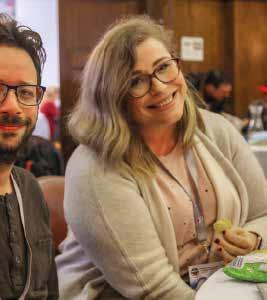
Rev. Amanda Hay will be Tuggeranong Uniting Church’s new Minister.
“I've always been impressed with Tuggeranong's commitment to social justice and inclusivity but more than anything, what stood out to me was their willingness to explore and adapt to the world around them and the different expressions of what church could be,” Rev. Hay said.
“I am looking forward to working in a team of exceptionally talented lay and ordained ministry agents who are prepared to explore and enact God's love in the Tuggeranong region and beyond. I look forward to the challenge of this new ministry role and my family getting to connect with old and new friends in the Canberra Region Presbytery.”
When asked by Insights as to what people could pray for, she said, “Prayer for smooth transitions and a continued sense of God's hand taking ours and leading us where we need to go. Prayer for Berowra Uniting Church and their continued ministry and for Tuggeranong as they prepare for the Hay family arrival.”
Rev. Elizabeth Raine was previously the minister at Tuggeranong Uniting Church, before her retirement from ministry at the end of 2022.
“Discerning that it is time to move onto a new placement is never easy for the ministry agent or the placement and since COVID, we have had so many ministry agents move or retire,” Rev. Hay said.
“While there is discomfort and pain in the midst of change, I think it's important to remember that we follow a God whose Spirit dances and weaves through our lives in directions we never thought it would take us and to find comfort and courage in that.”
JONATHAN FOYE
For more information about Tuggeranong Uniting Church, visit their Facebook page: facebook.com/tuggeranongunitingchurch


Pitt Street Uniting Church will host a range of works by Rev. Dr Rod Pattenden, specifically prepared for the Church space. The artist says the works celebrate the vibrancy of nature and the ecstasy of being alive.
According to Rev. Dr Pattenden, the large scale oil paintings offer queer perspectives on faith as a place inhabited by diverse bodies that change during the shifting seasons of life.
“These works disrupt the role of religion in defining boundaries,” Rev. Dr Pattenden said.
“They open up more fluid and sensual experiences that celebrate the embodied nature of being human.”
The offical launch event takes place on Friday 30 August from 6pm.
There will be a musical performance by Marion St Sacred Arts Project featuring the songs of Mikali Anagnostis and Gabi Cadenhead.
Retreat leader Susanna Pain will launch the artwork.
Rev. Dr. Josephine Inkpin is Minister at Pitt St Uniting Church.
“It is a delight to host this exhibition which brings together issues close to our hearts – the environment, LGBT+ gifts and the interface of sexuality and spirituality,” she said.
“The vibrancy of the work beautifully complements the architecture and wooden fittings of our heritage building. We are proud to be able to offer this unique and powerful exhibition to the city.”
The Church will be open Wednesday to Saturdays 10am to 2pm during the
exhibition, which runs from Saturday 31 August to Saturday 12 October. All works on exhibition are available for sale.
Original Bliss: Paintings by Rod Pattenden launches at Pitt Street Uniting Church on Friday 30 August at 6pm. Refreshments provided.
JONATHAN FOYE
For more information on Rod Pattenden’s work, visit his website: rodpattenden.id.au
The Rivergum Community Garden is a key project of Revesby Uniting Church.
Since opening in 2022, the garden has become a vibrant space used by many. It comprises native trees and grasses, an edible garden filled with fruit, vegetables, and indigenous bush foods, a street library, and sensory play spaces.
Thanks to a Synod Missional Grant, the congregation is going to add signage, seating, and shade as part of the project’s third stage.
Revesby Uniting Church council member Julie Bertram is the coordinator of the Community Garden project.

for everyone enjoying the garden,” Ms Bertram said.
“Having appropriate and comfortable outdoor seating and shade will make all programs more accessible throughout the year.”
“We look forward to seeing our local community gather around our garden in a wide variety of ways. Having seating and cover creates a space for learning, sitting and chatting, meditating, playing, reading, storytelling, and just being.”
THE GARDEN IS A VITAL RESOURCE IN CARRYING OUT OUR VISION AND WILL BE ENHANCED THROUGH THIS SYNOD GROWTH FUNDING
“We want our community to know about the garden and feel welcome to enjoy the space, ensuring they are comfortable when they visit,” Ms Bertram said.
“The Missional Grant will enable us to design and purchase a large, fixed sign to welcome the community into the garden. It will also provide contact details for further information. The sign will be clearly visible to those passing by and will draw attention to our Rivergum Community Garden.”
Ms Bertram told Insights that the current lack of seating and shade was limiting access to the garnde.
The Missional Grant will enable the church to plant a large tree to provide shade, as well as install a fixed structure to provide year-round shade for parts of the garden.
“This would enable us to hold outdoor workshops and varied activities undercover, providing sun-safe spaces
“Our goal is to run a variety of workshops and educational programs that promote environmental sustainability, literacy, and practice in partnership with local groups.”
Drawing on the congregation’s links with local Aboriginal Elders, the congregation also aims to host Yarning Circles and learn more about traditional arts such as weaving.
“At Revesby Uniting Church, we seek to move spiritual conversations beyond the church walls, forming and building on connections within our local community as we learn from the vision of Jesus,” Ms Bertram said.
“The garden is a vital resource in carrying out our vision and will be enhanced through this Synod Growth funding. The grant enables us to continue our dream of developing a colourful, welcoming space for all.”
JONATHAN FOYE

This training workshop will give attendees the opportunity to reflect on some insights regarding Coaching for those in Mentoring and Oversight relationships with those in Ministry Practice. Facilitated by Rev. Ben Gilmour : Director - Vital Leadership Team
What is a Coaching posture and focus?
The craft of deep listening
The Art of deep wisdom seeking questions
Navigating Anxieties, Basis and Blind spots.
Exploring Strengths Based Coaching
Coaching with “Soul”
Considerations for ministry and mission team coaching


The UCAF National Committee was formally closed at a special part at the end of Assembly. It came as item 19 from the Assembly Standing Committee.
The Assembly will now continue two items previously undertaken by the UCAF National Committee, the Joan Stott Bursary and Maintaining a relationship with the World Methodist and Uniting Church Women. Outgoing Chair of the National Committee Margaret Pedler and Secretary Pam Grant spoke on behalf of the UCAF. NSW and the ACT UCAF Synod Committee members Eldrene March (On the original National Committee), Margaret and Ron Gregory, Laraine Jones, and Nancy Axe all attended the closure service which concluded with the Fellowship Hymn. The UCAF Synod Committees of NSW and the ACT, VIC/TAS, South Australia, and Western Australia will continue, and hope to have interaction with each other.
Our last NSW and the ACT UCAF Synod meeting was held face to face at Wyong Uniting Church. We always enjoy our faceto-face fellowship time together. Unfortunately, the internet played up and our Zoom attendees had to miss out.
One of the groups we support, PPSEAWA (Pan Pacific and South East Asian Women’s Association has also concluded and will wind down its affairs. We thank Helen Richardson who has been our representative on this committee for many years.
Nancy Axe from the UCAF Synod Committee also represented us at the Annual Conference opening of the Presbyterian Women’s Association at PLC Croydon.
The Illawarra Presbytery Gathering in Nowra was a wonderful time of fellowship and sharing with over 60 attending. Special guest was moderator Rev. Faaimata Havea Hiliau who led a thought-provoking address on the Trinity with colourful
highlights. Appreciation Certificates were presented, and the offering collected went to The Flying Padre. A wonderful morning tea was also provided. Three over-90 year olds from the presbytery were also celebrated at the Jean Arnott Luncheon at Parliament House.
Rev. Graham Perry was special guest at the Hunter Presbytery Gathering late August. A full report will be in next issue.
The Sales Table has again received donations of Christmas cards thanks to Rev. Noreen Towers connections. These were available at the Nowra Gathering and have gone to some of the UCAF synod committees’ churches. Frames have also been purchased to compliment some of the cards created by Kay Weidemier.
The Stamp Committee still does not have the opportunity to attend stamp auctions. November is the proposed date for the warehouse opening. Stamp sales to date are close to $10,000.
Appreciation Certificates are still being Appreciation Certificates are available for 80, 90 and 100 year old members of your Fellowships and Congregations who have been active and involved in the Uniting Church. We recently did a special for a lady was 106 years old.
If you would like to share your fellowship news or have any questions, please contact Judy Hicks: judyh_rnh@hotmail.com
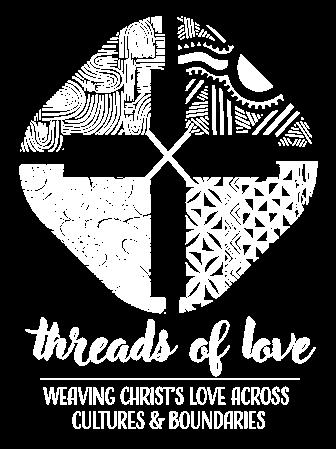
The 17th triennial Assembly meeting met at the Parramatta Novotel on Burramattagal land in Western Sydney from 11 to 16 July.
As well as the installation of Rev. Charissa Suli as President the meeting featured key decisions and next steps for the ACT2 Report.
This issue of Insights explores what the Assembly's important decisions mean for the life of the Uniting Church.

One of the meeting’s most significant moments took place on the first day, when the Assembly installed its 17th President, Rev Charissa Suli, in a jubilant celebration at a packed St Stephen’s Uniting Church on Gadigal land in Sydney.
The historic appointment of Rev. Suli as the youngest and first person of colour to lead the church nationally was joyfully celebrated by close to one thousand people who filled the Church while hundreds more watched online. The service was also the official opening of the 17th Assembly meeting.
The 17th Assembly has adopted three new visions for the life of the Uniting Church and established two new national Commissions.
Each day began with worship, led tby 17th Assembly liturgists Rev. Pablo Nunez, Rev Heewon Chang and Rev. Ellie Elia, and by Assembly members, the President and the Assembly worship band. Teaching was offered by Rev. Ken Sumner, Joy Han, Rev. Dr Bec Lindsay and Rev. Dr Jason Kioa. Read our worship stories from Day 2, Day 3, Day 4, Day 5 and Day 6.
On Friday, members were challenged to recommit to the work of reconciliation and justice in a celebration of the 30 th anniversary. In a program curated by the UAICC, it featured cultural dance, song, story, prayer and a powerful challenge to do better in our commitments to be in true relationship with the First Peoples of this land.
Assembly members also heard the UAICC report, where in a powerful and forward-looking address, National Chair Rev. Mark Kickett described Congress’ purpose: “for First Peoples to be autonomous and live freely in decision making as we minister with First Peoples and engage all peoples in theological, culturally safe, and holistic ways.”
THE 17 TH ASSEMBLY ADOPTED THREE NEW VISIONS FOR THE LIFE OF THE UNITING CHURCH
Through the course of the meeting the Assembly passed two proposals from the UAICC which called for a redesign and revival of the Covenant. Speaking to the proposal, Rev. Mark Kickett said, “We need the church to journey with us, so the groundswell of that is with our people.”
The resolution also endorsed and committed to implementing the relevant principles in the United Nations Declaration on the Rights of Indigenous Peoples (UNDRIP).
Rev. Sharon Hollis delivered her retiring President’s address on Friday morning, expressing her deep gratitude for the past three years.
The Assembly was blessed by the presence and insights of Uniting Aboriginal and Islander Christian Congress (UAICC) members, as the meeting coincided with the 30 th Anniversary of the Covenant between the UCA and the UAICC.
Rev. Dr Paul Dongwon Goh was announced the next Presidentelect. He will serve as President from 2027-2030 and will be the first Korean to do so. The Assembly also appointed Mr Andrew Johnson as the new Assembly General Secretary.


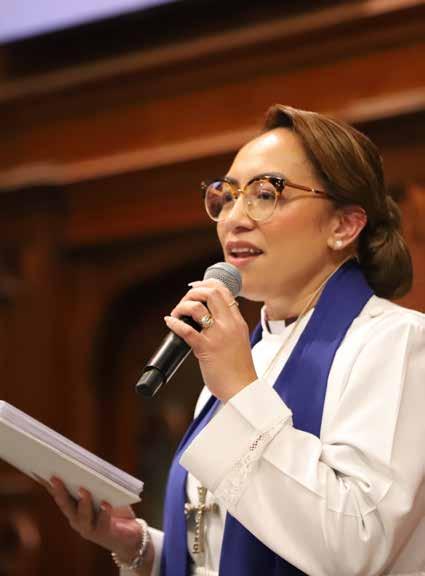
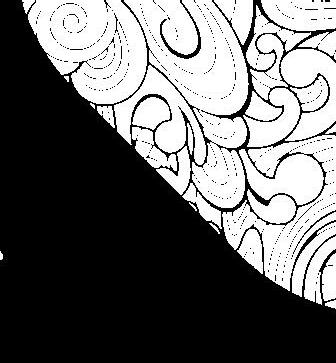
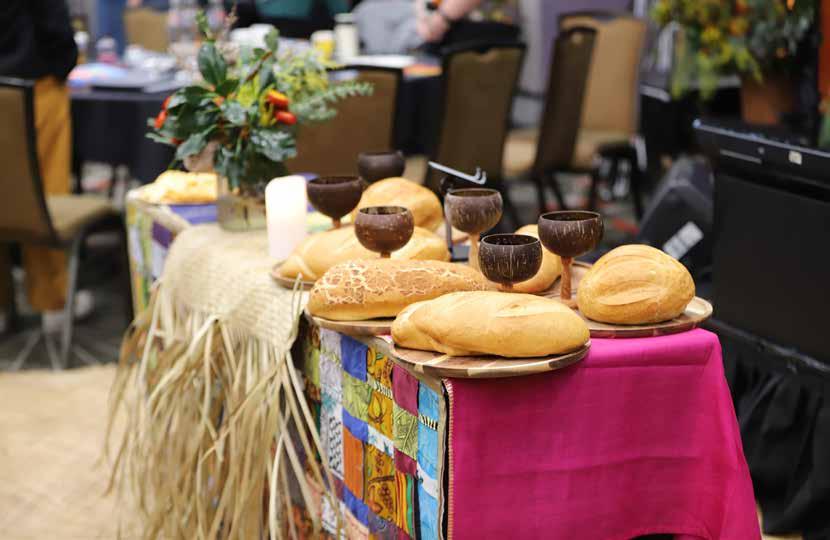
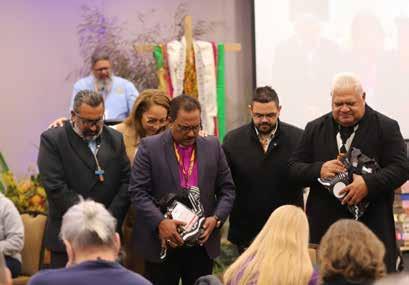
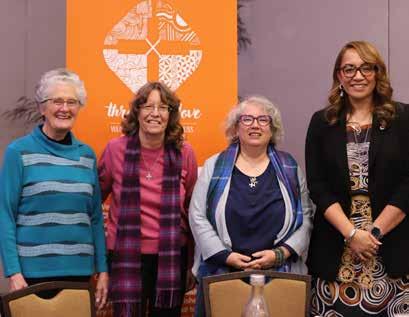



Mr Johnson is currently the Assembly’s ACT2 Project Lead and is an established strategy, change and governance leader. He made a response following the announcement of the ballot result, which was received by acclamation.
Renowned Korean-American theologian Rev. Dr Grace Ji-Sun Kim delivered her Cato Lecture on Saturday night, issuing a challenge to image God in new ways.
Speaking off the back of her most recent book, How God became White, Grace challenged members to reflect on how racism and ‘white-ness’ have shaped images of God for centuries.
Over the six days President Rev. Charissa Suli modelled extraordinary spiritual leadership as the Assembly moved through a number of proposals, chairing the meeting in a spirit of openness and prayer, and creating a space where all voices could be heard and God’s presence could be felt.
In presenting the proposal, Steering Group Convenor Richard Arnold said “the job of reducing emissions is a task for us all.”
It also passed a proposal directing the Beneficiary Fund Committee to report to the Assembly Standing Committee (ASC) as part of a process to monitor the sustainable (ethical) portfolio of Mercer Super Trust.
In an emotional moment, Rev. Sharon Hollis moved a Minute of Appreciation for the Uniting Church Adult Fellowship National Committee which has ended its ministry after 42 years.
REV. CHARISSA
SULI MODELLED
EXTRAORDINARY SPIRITUAL LEADERSHIP
Concluding the significant work requested at the 16th Assembly and undertaken over the past 18 months, a series of decisions were made on the ACT2 Project. The Assembly adopted three new visions for the life of the Uniting Church, established two new national Commissions, and requested further investigation into the Uniting Church’s national structure.
It also adopted a proposal that seeks to affirm, welcome and honour the life and faith of transgender, intersex and gender diverse people in our Church.
It resolved to recognise three ecumenical documents as “continuing witness” to the Gospel of Jesus Christ”. The Belhar Confession, The Joint Declaration on the Doctrine of Justification and Laudato si’ have been recognised as part of a new category of statements or confessions of faith from other churches from which we might learn.
The work of the Assembly’s Net Zero Emissions Steering Group will also continue into the next triennium after a decision was made to continue its mandate to support and encourage the whole church to move towards zero emissions by 2040.
The meeting formally recognised the 30 th anniversary of both the Covenant and the Manual for Meetings with a warm and candid presentation by Dr Jill Tabart, the 7th and first woman President of the Uniting Church. Dr Tabart shared her recollections of the signing of the Covenant Statement and using the Manual at the Assembly meeting for the first time in 1994.
The Assembly also gave thanks to God for the work and witness of the National Council of Churches in Australia as it marks 30 years.
On the final day the meeting passed Minutes of Appreciation for the significant leadership and work of people involved in the life and ministry of the Assembly including its committees and agencies. Elected ASC members, Chairpersons and Advocates were announced.
Assembly General Secretary (Interim) Rev. Lindsay Cullen offered thanks to all who had contributed to the planning, organisation and leadership of the meeting, including Assembly and Synod staff, the worship team, Business Committee, Facilitation Committee and Local Arrangements Committee.
The meeting closed with a powerful and joyful time of worship and with communion led by President Rev. Charissa Suli and President-elect Rev. Dr Paul Goh. Members departed for home on Tuesday afternoon, nourished and renewed for the journey ahead.
BETHANY BROADSTOCK UNITING CHURCH ASSEMBLY COMMUNICATIONS MANAGER
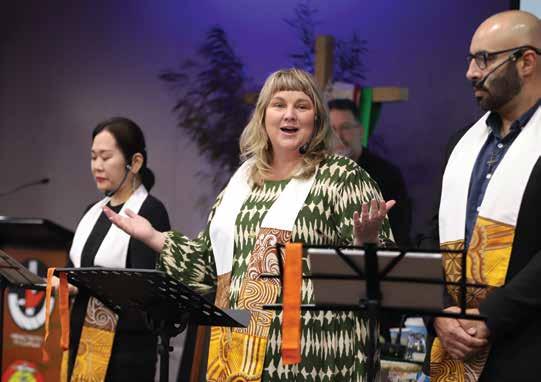
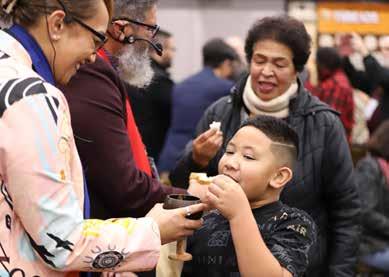


MORE INFORMATION AND ASSEMBLY RESOURCES:
To access all the Assembly stories and information, please go to the Assembly website: uniting.church/17thassembly
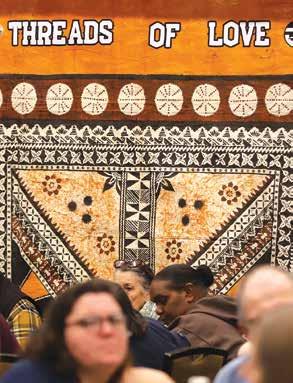
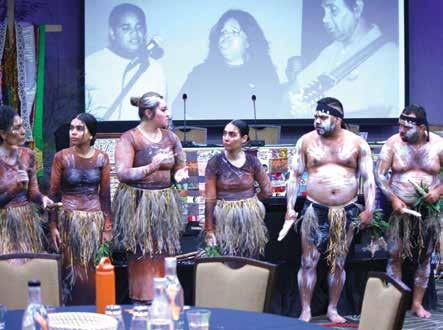


The 17th Assembly made a series of decisions arising out of the ACT2 Project, adopting three new visions for the life of the Uniting Church, establishing two new national Commissions, and requesting a further investigation into the Uniting Church’s national structure.
Substantial work was undertaken by the 17th Assembly Facilitation Committee in relation to the ACT2 proposals, which were discussed at length in Community Working Groups and in meeting plenary.
The 17th Assembly affirmed an opening statement which preceded the proposals:
We open ourselves to the gift of the Spirit, given in order that we may not lose the way. With thanksgiving for the past 47 years of our life, and after taking a long, loving look at the reality of our present, and with hope in God’s faithfulness for our future, we commit to continue our journey together. We believe now is the time to reshape our life so we may better live into God’s call in our time and place. By centring life-giving communities of discipleship and mission, cultivating a flourishing theological culture and deeply sharing in our common life and wealth we will treasure Christ’s gift of abundant grace, share this gift with our world and pass it to future generations.
A visible and accessible network of intentional communities engaged in life-long learning to equip people to courageously follow Jesus and participate in God’s mission in contemporary Australia.
The Assembly established a new national Commission for Theology, Formation and Leadership to see this vision implemented across the life of the Uniting Church.
LIVING OUT THE VISION FOR SHARING OUR COMMON LIFE AND WEALTH
It adopted a vision for local Uniting Church communities: Communities of faith will sustain a life of worship, build one another up in love, grow disciples of Jesus and participate in God’s mission. These diverse communities of faith will shape their life in response to God’s call in their context and deepen their relationship with God, one another, the wider church and the world.
It adopted a second vision for a National Network for Theology, Formation and Leadership, which refers to those institutions and communities – including but not limited to theological colleges – where people are educated and formed for discipleship, mission and ministry. It envisions:

The Commission will have Terms of Reference and a skilled membership both to be determined by the ASC. The ASC has been requested to ensure the membership reflects the theological and other diversity of the Church and includes people with qualifications and experience in theological education and ministry formation.
The Assembly adopted a suite of principles to guide the work of the Commission.
The Assembly adopted a third vision for the ordering and resourcing of the whole Church:
A network of deeply connected councils responding to God’s call to enter more fully into mission through healthy oversight of ministry and mission, celebrating our diverse and shared identity and being faithful stewards of our common life and wealth.
It also resolved to “Call to the Church, in living out the vision for sharing our common life and wealth, to prioritise sharing our resources with one another for the benefit of the whole Church.”
The Assembly established a new national Commission for Governance, Resourcing and Administration to lead the work of implementing the vision across the Church.
The Assembly Standing Committee will finalise its terms of reference and establish a process to fill the membership
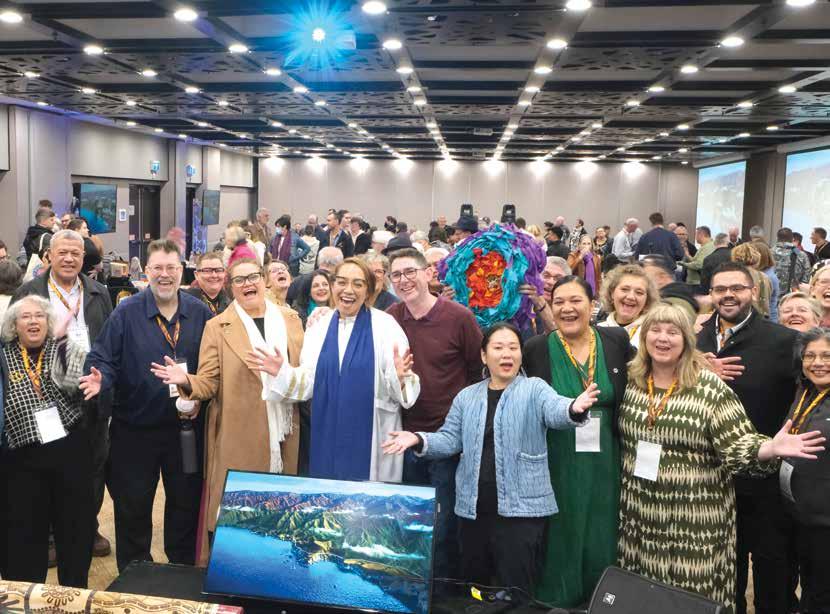
of the Commission, which will be drawn from the Uniting Aboriginal and Islander Christian Congress, Congregations, Presbyteries, Synods, Assembly and agencies.
Like with the first Commission, the 17th Assembly adopted a series of principles to guide the work of the Commission for Governance, Resourcing and Administration.
This Commission will undertake a feasibility study related to the national structure of the Uniting Church, investigating the consequences, risks and opportunities of both a three-council and a fourcouncil model.
This process will be undertaken in collaboration with Congress leaders, Church Councils, Presbyteries, Synods, the Assembly and agencies of the Uniting Church. The Commission will report to the 18th Assembly in 2027.
Noting that some decisions made as part of the ACT2 direction may require changes to the Uniting Church Constitution, the Assembly also prescribed a process by which the Assembly Standing Committee will make those changes. The process ensures adequate consultation with the Legal Reference Committee, Synods, and Presbyteries.
BETHANY BROADSTOCK
UNITING CHURCH ASSEMBLY COMMUNICATIONS MANAGER


This is an edited version of a sermon delivered by Nathan Tyson on 10 July 2024 at the Uniting Church Centre For Ministry. The full version is available on Insights’ website: insights.uca.org.au
Iam honoured today to have the opportunity to speak to you on this 30th Anniversary of the Covenant Statement.
At the outset, it is important to acknowledge the Covenant Statement was created as a response to trauma experience by Congress, when the Church essentially broke a promise. The Church had undertaken not to engage in bicentennial celebrations in 1988, but later some parts of the Church did in fact celebrate the bicentennial.
As a result, I believe discussions took place over some years, and 30 years ago on this day, the then President of the Uniting Church read the Covenant Statement, and the UAICC provided their response.
The Covenant Statement of 1994 remains one of the most important documents in the life of the Uniting Church. It is a powerful truth telling document, that acknowledges the role of the Christian Church in the colonisation of this country, and in the dispossession of Aboriginal and Torres Strait Islander peoples from their ancestral lands.
The Statement, for example, includes the following paragraph:
“We regret that our churches cooperated with governments in implementing racist and paternalistic policies. By providing foster homes for Aboriginal children, our churches in reality lent their support to the government practice of taking children from their mothers and families, causing great suffering and loss of cultural identity. Our churches cooperated with governments in moving people away from their land and resettling them in other places without their agreement.”
In a very gracious piece of writing, the UAICC responded to the Statement, read out by Bill Hollingsworth, which included the following paragraphs:
“The UAICC believes it is just for the Uniting Church, as a result of its enlightened understanding of the Gospel implications of creating new community, to offer a practical response to the past history of dispossession and resulting disenfranchisement of Aboriginal and Islander people from their social, economic and spiritual development of Australia, by taking action to empower the UAICC ministry by offering to share the assets of the Uniting Church.
As a result of the violent dispossession and resulting isolation from economic empowerment in Australia, within a great number of our people there has developed a deep anger and resentment of European people.
Therefore it would be wrong to just say “I forgive”, without reaching a commitment to work together to lay a new foundation upon which we may build a more just
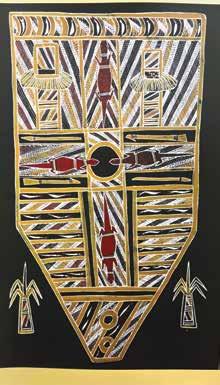

The Covenant Statement is a truth-telling document. It commits the Church to supporting the UAICC work with First Peoples to address the disadvantage impacting Aboriginal and Torres Strait Islander peoples as a result of colonisation and dispossession.
THE COVENANT STATEMENT OF 1994 REMAINS ONE OF THE MOST IMPORTANT DOCUMENTS IN THE LIFE OF THE UNITING CHURCH. IT IS A POWERFUL TRUTH TELLING DOCUMENT
future together, by ensuring that the Uniting Church plays an active role in providing adequate resources to address the present disadvantages caused by the past injustices and dispossession by the invasion of this country.
Your commitment to be practical in seeking to be united in this relationship will be assessed by your decisions to resource the Congress ministry and to be actively involved in ministry alongside and with Aboriginal and Islander people to change the present disadvantage.”
In today’s terms, we might say that the Uniting Church in Australia, in 1994, committed to working to help “close the gap” and reduce the socio-economic disadvantage impacting First Peoples as a legacy of colonisation.
Sadly, of course, we know that in 2024 “the gap” in socio-economic indicators remains wide, and significant disadvantage continues to impact Aboriginal and Torres Strait Islander peoples. This work of addressing disadvantage impacting First Peoples, described in the Covenant Statement, remains to be done.
I am often asked how I think about the Church’s responsibilities to First Peoples from a theological perspective.
Four passages that I think are helpful in thinking about the Church’s commitment to First Peoples are as follows:
THE PARABLE OF THE GOOD SAMARITAN (LUKE 10:25-37)
The teaching is that the good neighbour is the one who helps the injured man in the road – the one who shows mercy and compassion.
IN MATTHEW 22:36-40
we are taught of the two greatest commandments – the first of course being to love God with all of our ability, and the second being to love our neighbour as ourselves.
IN MATTHEW 25: 31-40 we hear Jesus tell us about the day of judgement. The newsflash is that we will not be judged on the number of times we attend Church, or how much we put in the offering plate, or how much money we have in the bank. We will be judged on how we treat the least in our society.
CONTINUED ON PAGE 26
PHOTOS: SIGNING OF THE COVENANT 1994. FROM THE UNITING CHURCH IN AUSTRALIA, ASSEMBLY ARCHIVES.
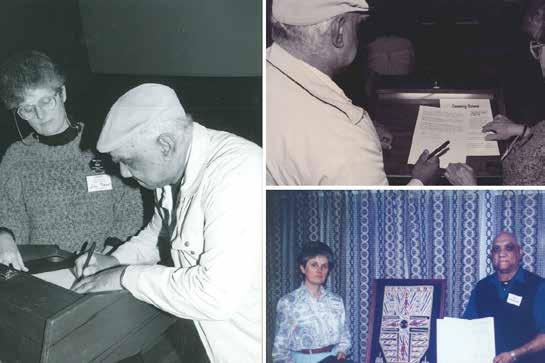
THE PARABLE OF THE GREAT BANQUET (LUKE 14:15-24)
This is a great parable with a number of layers, worth several reads. In short, Jesus is explaining that the invitation to God’s Kingdom is open to all, and only those who reject the invitation will not be welcome. For me, this reassures me that Aboriginal and Torres Strait Islander Peoples, and in fact all marginalised peoples (ie. Those living outside the city walls in the story), are welcome in the Kingdom.
When I consider these passages, and the inherent teachings within them, I struggle to understand how the early Churches in Australia, and how even today many Churches still, treat First Peoples as “other” and engage in conscious and unconscious bias towards us.
Today, this nation still in many ways exists as a colony – we are still tethered to the British monarchy, and Aboriginal people continue to feel the impacts of colonisation… we are the marginalised, the minority, the disadvantaged, and the poor. We are dispossessed,
disenfranchised, and discriminated against. We are significantly overrepresented in gaols, and we have some of the highest youth suicide rates in the world.
This is not good enough.
In so many ways, our views, our sovereignty, our cultural authority, and our desire to be connected to our ancestral country, are basically ignored by most of the Governments that run this country… Victoria seems to be breaking the mould a bit at present, so there are glimpses of change. Glimpses of hope.
Of course, we’ve had glimpses of hope before. We had hope for a Voice to Parliament. We had hope after the Apology to the Stolen Generations that child removals would be greatly reduced. We had hope when Bob Hawke promised a Treaty…. And I am sure there was hope in 1994 when the Covenant Statement was made.
I think it is important that we don’t leave the truth-telling back in 1994.

ARTWORK: PATH OF THE ANCESTORS GRACE WILLIAMS
We mustn’t assume that the Covenant Statement has done everything required – because while it says some important things, in many ways it has yet to be effectively actioned… there remains much work to be done.
My experience in travelling to many congregations and church groups around NSW and the ACT, over the last few years is that relatively few members of the Uniting Church are aware of the Covenant Statement.
For many people in many of the congregations of our Church, the Covenant Statement is out of sight and out of mind. This needs to change.
I think the challenge for the UCA is to engage with First Peoples as equals – as equals in Christ and as equals in the Church.
For example, imagine if all of our Church Councils were encouraged to have at least one Aboriginal or Torres Strait Islander member.
I think the Covenant Statement calls the Church to act, and makes some broad
THE UNITING CHURCH PLAYS AN ACTIVE ROLE IN PROVIDING ADEQUATE RESOURCES TO ADDRESS THE PRESENT DISADVANTAGES CAUSED BY THE PAST INJUSTICES AND DISPOSSESSION BY THE INVASION OF THIS COUNTRY.

commitments, but it doesn’t really set out any specifics. It’s aspirational rather than operational, so to speak. And this is perfectly OK. However I think that some sort of strategy or guidance as to how the Church at its various council levels might take practical and tangible actions to fulfil Covenant commitments.
So we can see that the Covenanting Statement was a necessary and important document in its time, and remains an important document in the life of the Church.
But the Covenant Statement is only words on paper. It means nothing if it does not impact the actions and activities of the Church. It means nothing if we do not preface every significant decision in the life of the Church by asking:
“How does the Covenant Statement impact this decision, and how does it guide us in our discernment and determination?”
NATHAN TYSON HEAD OF FIRST PEOPLES STRATEGY AND ENGAGEMENT

As the Uniting Church marks the 30th anniversary of the Covenant and the 15th anniversary of the Preamble, Aboriginal artist Grace Williams has shared two new artworks that will be featured across Assembly resources and communications to mark these significant milestones in our journey as First and Second Peoples.
Grace is the Community and Cultural Resource Officer, Leprena - UAICC Tasmania. We thank Grace for sharing her creative talents and her deep connection to story, culture and Country.
Find out more about the artworks featured here:
uniting.church/covenantanniversary-artwork
Rev. Sally Yabsley-Bell was inducted into her new role as Kinross’ school chaplain in April. She told Insights that this ministry is an important one that is supporting a diverse cohort of young people in their faith journey.
“Kinross is a busy School doing amazing things,” Rev. Yabsley-Bell said.
“I am loving my new role here and how open the school is to try new things and letting me be as involved in the school across many different areas. This term I will be helping students volunteer at Riding for the disabled, as well as coaching a hockey team, and leading lunch time programs, leading chapel and religions classes.”
Rev. Yabsley-Bell nominated a wide range of highlights from her first months in the role.
“My highlights have been just how keen the students are to be involved. Each Junior school class from Year 3 to 6 take turns leading a chapel service each term,” she said.
“They help write the prayers, choose the songs, and make videos or skits if they feel they link in with the service’s theme.”
“By accident I asked one class to be the chapel helpers twice in a term and the class that missed out let me know just how unfair that was. The class I asked twice, however, didn’t tell me they had already had their turn, because they wanted to lead chapel as much as possible!”
“It is such a privilege to be welcomed into the lives of so many students and given the opportunity to express God’s love for them all. I think every day in school chaplaincy is a blessing.”
“Last term while talking about what a sacrament is and learning about communion, I worked with Year
5 and 6 to rewrite or translate the last supper into language they would use. They had so much fun exploring what the Bible said about the last supper trying to see how many times they could put words like ‘sigma’ and ‘Skibidy’ into the story.”
“They then filmed their versions of the last supper and were about to watch them back and see if this exercise helped them better understand the text or if it confused the story for them. They were able to play with text criticism and theology in a way that was far more profound than I had expected.”
Rev. Yabsley-Bell said that the scale of her ministry was sometimes a challenge.
“The school is so large and it is always filled with events and excursions and I just want to be in all places at once. “
“Kinross is a very busy school offering up so many opportunities to its students. It is amazing to see the diversity of options available to the students. The resources in the school are set up to support students who are academically minded, who excel in sport, who come from farming families, for those who are creative in the arts, music, drama, textiles, and more.”
“The challenge for me is to make sure my messaging is as inclusive. To make sure both the conservative and progressively minded students and staff feel supported.”
JONATHAN FOYE


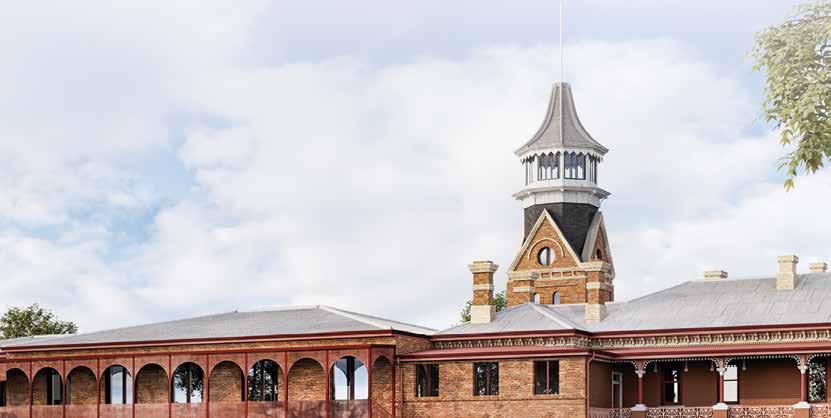

IT IS SUCH A PRIVILEGE TO BE WELCOMED INTO THE LIVES OF SO MANY STUDENTS AND GIVEN THE OPPORTUNITY TO EXPRESS GOD’S LOVE FOR THEM ALL
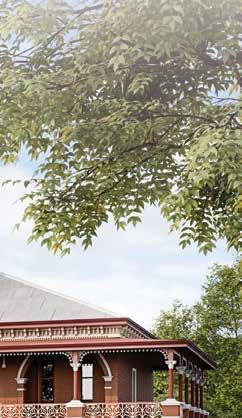
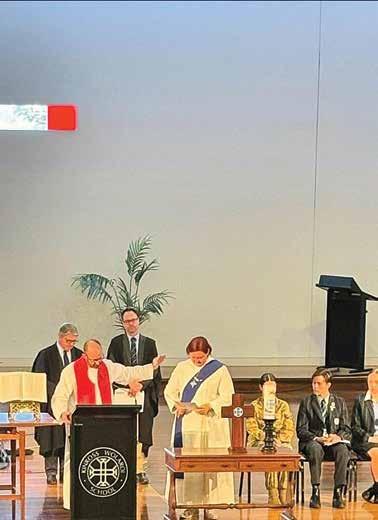

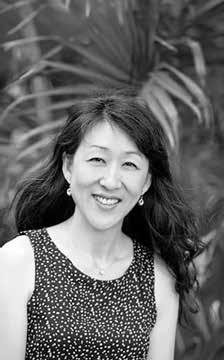
Newly appointed President Rev. Charissa Suli prayed for Grace before she was introduced by Rev. Fran Barber, member of the Cato Trust.
“We are extremely fortunate tonight to have the Rev. Prof Grace Ji-Sun Kim give the Cato Lecture for 2024,” Rev. Barber said. “She is a world scholar in feminist and postcolonial theology. She is the author or editor of no fewer than 24 books.”
Renowned Korean-American theologian Rev. Dr Grace Ji-Sun Kim has delivered a powerful Cato Lecture to the 17th Uniting Church Assembly, urging the church to take up new tools in the struggle for justice and to leave the ‘white Jesus’ behind.
oppressions reinforce each other to create new categories of suffering.”
She also quoted from American professor and feminist Audre Lorde: “There is no such thing as a single-issue struggle because we do not live single-issue lives.”
WE NEED TO CHALLENGE OURSELVES AND OUR ASSUMPTIONS AND LIBERATE CHRISTIANITY
“Born in Korea and brought up in Canada, she brings a unique perspective to her theological work and writes generously from her own experience which brings the issues alive.”
Giving her lecture the theme Intersectionality and Love, Rev. Dr Kim began with the framework of intersectionality – a tool for analysing the dynamics of injustice which has become crucial for her as a theologian.
“We have to move away from this whiteness of Jesus. The whiteness of Jesus became the architecture of white supremacy”
“Intersectionality is so important for us today because it’s trying to say that all these different injustices that are present in our society today – gender injustice, racial injustice, climate injustice and economic injustice – these are not separate little silos, these are all intersecting forms of injustices.”
Rev. Dr Kim referred to the work of Kimberlé Crenshaw, a scholar of critical race theory who coined the term and the concept: “The idea that multiple
“This is a new way of looking at how different injustices people experience collide and intersect. They’re not just in society, they’re also in our churches. Ageism, homophobia, Islamophobia, sexism, racism, ableism. These oppressions are interrelated and thrive off the same economic and social powers.”
“There is no hierarchy of oppressions. Rather, people experience multiple oppressions simultaneously. The call to dismantle one oppression will inevitably lead to the work of dismantling the other oppressions.”
“As the Body of Christ, as the Uniting Church, how are we going to harness this tool to overcome the injustice which exists right now in our midst?”
Rev. Dr Kim used the analogy of the kaleidoscope as a way of understanding intersectionality.
“Intersectionality is a lens for understanding how gender, race, social class, sexual identity, and other forms of oppression can find a juncture point, flowing together to create something new.”
Borne out of her own experiences as a child newly migrated to Canada, Grace explored the particular injustice of racism which is a feature of her work.
Speaking off the back of her most recent book, How God became White, she
challenged members to reflect on how racism and ‘white-ness’ have shaped images of God for centuries.
“I grew up believing in a white male God. Nobody challenged it. I never challenged it. Nobody in this room has ever seen God but for some reason every painting, every representation – we continue to talk about a white male God.”
The propagation of this myth of a white God and a white Jesus has had a devastating effect that has rippled across the globe through generations.
“We have to move away from this whiteness of Jesus. The whiteness of Jesus became the architecture of white supremacy. The white Jesus was used to colonise countries around the world, engage in holy wars, and enforce enslavement and genocide.”
“The contemporary church cannot be understood apart from its history of colonialism, racism, misogyny, homophobia, and violence. An intersectional church must reckon with this oppressive past and its ongoing oppressive legacy in the contemporary church.”
“If these same languages continue to perpetuate racism and sexism even now, we need new languages and images.”
“How are we going to understand each other? How are we going to live with each other? How does God appear to us? The language we have – it’s metaphor. Metaphors point us to who God is, they are not God.”
“We need to challenge ourselves and our assumptions and then liberate Christianity so it will be life-giving to all people. How are we as the Uniting Church going to practice this?”
Drawing on the theme for the 17th Assembly, Grace urged members to weave new threads of love by, embracing richer images and drawing on available tools to understand each other’s experiences and overcome fear.
“There is sometimes a fear of the unknown. We are afraid to love and embrace those who are different from us. We have to overcome that if we are going to love.”
After responding to questions from the attendees, Richard La’Brooy offered a vote of thanks.
JESUS WAS A MAN ON THE MARGINS BUT OUR IMAGES OF HIM ARE ALWAYS FROM THE CENTER
“Grace, thank you for reminding us that injustices are not separate but intersecting. Thank you for giving us this lens through which we can address these issues and respond.
We in Australia know the story of racism deeply. We have heard, experienced and lived the effects of racism in this country. The question for us as a church is how to dismantle these systems that oppress. Thank you for challenging us to think about how we image God, and to image God in different ways. Jesus was a man on the margins but our images of him are always from the center. Thank you for challenging us to think about God from the margins which is where Jesus was.”
The Cato Trust was established in 1928 by Methodist philanthropist and lay leader Dr Fred Cato and came into being in 1935. Since then there have been 28 Cato Lecturers.
BETHANY
BROADSTOCK UNITING CHURCH ASSEMBLY COMMUNICATIONS MANAGER
Rev. Dr Sathi Clarke virtually-delivered an insightful lecture on the topic “Jesus Within Islam” on 25th July 2024. This lecture focused on how Jesus is viewed within the Islamic tradition and the implications for interfaith dialogue.
Rev. Dr Clarke shared his experiences of living in an inter-religious world, growing up in Chennai, India. He emphasised his commitment to understanding and respecting other faiths, which has been a significant part of his journey for over 20 years.
Rev. Dr Clarke outlined three principles inspired by Krister Stendahl, a New Testament scholar and Bishop of Stockholm, which guide his approach to inter-religious understanding:
1. Ask the adherents of that faith, not its enemies.
2. Don’t compare your best with their worst.
3. Leave room for holy envy (to find elements to emulate from other faith traditions)
These principles helped frame his exploration of Jesus within Islam, aiming for genuine understanding rather than comparison.
Rev. Dr Sathi Clarke structured the lecture into three sections, examining Jesus in Islam through the lenses of the Quran, the Hadith, and Muslim piety.
Rev. Dr Clarke highlighted that Jesus, or Isa, is one of the most mentioned prophets in the Quran, appearing in 90 verses. He is deeply respected and honoured, and many titles given to Jesus in Christianity are also found in the Quran. Clarke emphasised, “Every Muslim neighbour we have had any form of relationship with has deeply imbibed this notion that there is only honour, dignity, divine favour, and blessedness in this figure of Jesus.”
am Allah’s servant. He has given me the book and has made me a prophet.”” (19:30). Rev. Dr Clarke noted that while every messenger is a prophet, not all prophets are messengers, underscoring Jesus’ unique status.
Muslims revere Jesus as the “son of Mary” rather than the “Son of God.” The Islamic community follows strict monotheism, emphasising the oneness of God and rejecting any form of association or partnership with God. This fundamental aspect of Islamic theology influences how Muslims view Jesus and his role as a prophet. Rev. Dr Clarke noted, “For Muslims, the idea of God having a son is incompatible with their understanding of God’s absolute oneness.” Therefore, Muslims are called to love Jesus deeply but not to elevate him to divine status.
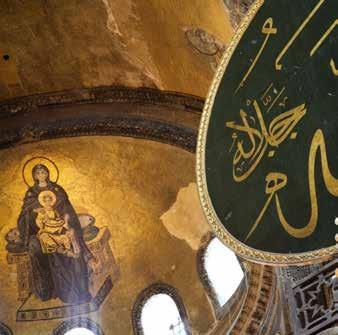
Muslims believe Jesus was conceived miraculously by God’s word delivered to Mary by the angel Gabriel. However, they do not believe Jesus was crucified. Instead, they hold that someone else took his place and that Jesus was taken up by God, to return at the end of time to defeat the Antichrist and judge humanity. This belief negates the need for atonement through crucifixion, a key difference from Christian theology. Clarke stated,
“The parallels between Islam and Christianity should be drawn keeping in mind that Jesus and the Quran seem to hold together the purity of the revealed word that’s gifted to us, and Mary and Muhammad are parallel instruments through which the purity of the Quran and Jesus are gifted as God’s revelation.”
The Quran attributes several titles to Jesus, including Prophet (Messenger) of Allah, Son of Mary, Sign of God, Messiah, Word of God, Spirit of God, and Servant of Allah. In Islam, Jesus is considered one of the elite prophets, alongside Noah, Abraham, Moses, and Muhammad. Among the 124,000 prophets and 313 messengers in Islamic tradition, Jesus holds a special place. The Quran states, “He (Jesus) said, “I
Hadith, a collection of words and deeds of Prophet Muhammad and early Muslims, serves as a secondary source of revelation to the Quran. It was passed orally for two centuries after Muhammad’s death and codified in written form only after the 9th or 10th century.
In the Hadith, Muhammad and Jesus are described as “brothers in faith.” “Allah’s messenger (Prophet Muhammad)
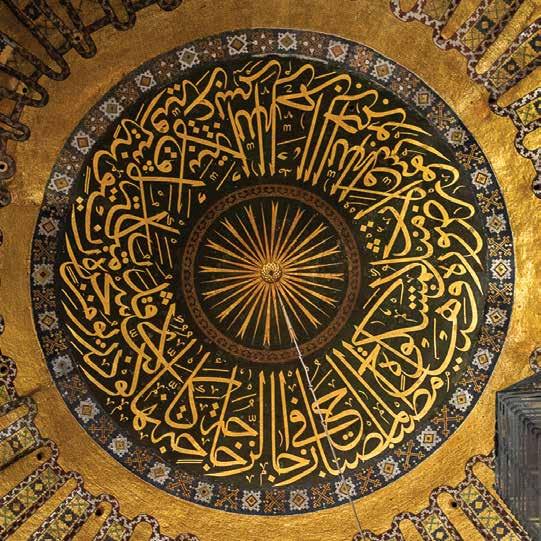
said: “I am most close to Jesus, son of Mary, among all of mankind in this worldly life and the next life. They said: Allah’s Messenger, how is that? Thereupon he said: Prophets are brothers in faith, having different mothers. Their religion is one, and there is no apostle between us (between me and Jesus Christ).” (Abu Huraira, died 681 CE). Rev. Clarke emphasised that he uses such references from Hadith and the Quran to highlight the commonalities between Muslims and Christians. He criticised media portrayals that focus on superficial aspects of Muslim identity, urging people to see beyond these and recognise the shared faith and love for Jesus.
The Hadith also describes Jesus as untouched by Satan. It is believed that Satan touches every human at birth except Jesus, whom Satan failed to touch.
JESUS OF MUSLIM PIETY
Rev. Dr Clarke quoted Mahmoud Ayoub (1935-2001), Professor of Islamic Studies at Temple University, who distinguishes between Jesus of Islamic faith and Jesus of Muslim piety:
“For Islamic faith, Jesus, like Adam, is a special creation of God, but unlike Adam, he is free from sin. He is a ‘blessed’ and righteous servant of God, ‘high-honoured in this world and the next,’ and one of those who are nearest to God (Q. 3:45). For Muslim piety, Jesus is a model of true Islam, or total submission to God. He lived in God’s presence, free from all attachments to this world and its vain pleasures. He is
the soul and solace for the poor and oppressed, and a stern reproach for the rich and greedy oppressors. For Sufis, the ‘friends of God,’ he is an example of true piety and trust in God, and through his gracious miracles, he embodies for all faithful Muslims God’s gift of life and healing.”
Rev. Dr Clarke stressed the importance of interfaith dialogue in fostering peace and understanding between different religious communities. He mentioned the efforts of the Uniting Church in promoting such dialogues and building bridges between faiths. He encouraged attendees to engage in respectful conversations, learn about each other’s traditions, and participate in shared community activities.
Rev. Dr Clarke suggested several practical steps to facilitate interfaith dialogue:
1. Education: Learn about each other’s religious texts and traditions.
2. Respectful Listening: Approach conversations with a willingness to listen and understand.
3. Shared Activities: Participate in joint community service projects to build relationships and trust.
Watch the complete video (tinyurl.com/JesusinIslamUCA) to get a deeper understanding of the intricate ways in which Jesus is viewed within Islam and the potential for interfaith dialogue.
ADITEE VORA

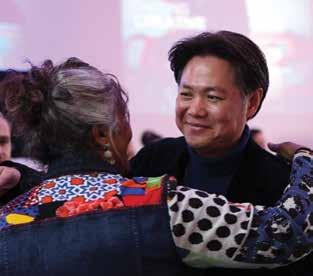
The beautiful thing about gathering as creatives is not only hearing the joys and challenges of the journey but also discovering the innovative ways leaders are shaping their mission through the arts.
Each story of triumph and struggle reveals how artistry can transform spiritual practice, offering fresh perspectives and new solutions for engaging with communities in deeply meaningful ways.
In this article Tash Holmes, Mission Catalyst with Uniting Mission and Education spoke to Rev. Myeongcheol John Oh about how the intersection of faith and creativity is transforming Mossman Uniting Church’s ministry.
Can you share specific examples of how visual arts, music, or performing arts is being used in the life of your community and church?
In our community at Mosman Uniting Church, visual arts, music, and performing arts play a significant role in our worship and outreach. As a minister, I believe that creativity is not just about what I can create but about fostering an environment where the people of God can rediscover who they are and who our God is through various forms of art.
We incorporate music across both traditional and contemporary styles in our worship services. I also bring dance into worship, particularly hip hop dance, which has resonated with many, including high school students and refugee students I teach in the wider Uniting Churches. Beyond that, I offer free hip hop dance classes at our church, and I’ve been invited to share hip hop dance with a Parkinson’s dance company at a local senior centre, which has been a beautiful way to connect with the community.
The Parkinson’s Choir is another vital ministry. Every Thursday, our church opens its doors to people with Parkinson’s disease, offering them a chance to build community through music. This ministry has become a cherished part of our church life. Photography also plays a key role in our ministry. Visual art like photography can often communicate and inspire in ways that words cannot. Additionally, we have a stop-motion ministry for children and young leaders, where we create Bible story videos for our first Sunday services. This creative process engages the younger generation in the narrative of our faith.
On the first Sunday of each month, we bake communion bread at the beginning of the service, which the children and mothers bring for the offering. This act of baking and breaking bread together is a form of performing arts that connects us deeply with the story of the feeding of the 5000. I lead a bonsai arts ministry, which is a unique blend of visual art and pastoral care. Bonsai is not just a craft but a spiritual practice that fosters healing, prayers, and self-reflection. Through these creative expressions, we aim to make the worship experience more meaningful and to reach out to our community in diverse and impactful ways.
In what ways have you seen spiritual growth at the intersection of faith and creativity?
I've witnessed profound spiritual growth at the intersection of faith and creativity, particularly in how creative expression embeds the Bible's stories and teachings into our community's hearts and minds. For example, when the children in our church created a stopmotion video of the Easter story, they not only engaged deeply with the Holy Week narrative but also memorised the entire story and several Bible verses. This creative process helped them internalise the story in a way that mere listening or reading might not achieve.
Whether through visual arts like stop motion or through music, creative ministry serves as a powerful tool for helping people remember and live out the messages they encounter. Music, for instance, isn't just about the joy of singing; it embeds the words, emotions, and spirituality of our faith into our daily lives. Creativity allows us to remember in different artistic ways, making the stories and teachings of our faith more accessible, memorable, and transformative.
It goes beyond understanding, inviting people to actively participate in the story of faith and letting that story shape their lives.
What excites you about connecting with a wider network of creatives across our Synod? Why do you think it's important?
I’m excited about connecting with a wider network of creatives across our Synod because it reflects and values justice, equality, hope, peace, and love –core elements of our faith. This network isn’t just about sharing resources, but about recognising the inherent creativity in all of us, as we are made in the image of a creative God. Inspired by Genesis 1:1 “In the beginning when God created the heaven and earth,” I believe that connecting with other creatives allows us to live out the gospel in innovative ways, reinforcing our shared identity and strengthening our collective impact on our communities and beyond.
TASH HOLMES MISSION CATALYST UNITING MISSION AND EDUCATION
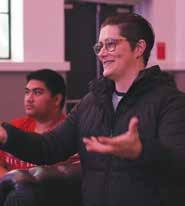

In June, on the first day of winter, creatives gathered for the first Enliven workshop, where artists and church leaders delved into the intersection of creativity and worship. Gifted artists and musicians converged for a day filled with workshops, thought-provoking panels, and an evening 'After Dark' session with live music, poetry, and storytelling. Participants embarked on a journey of exploration and connection, delving into themes that ranged from nurturing the creative soul and merging artistic beauty with congregational engagement to crafting compelling digital narratives and mastering the art of song writing for worship.
‘Enliven was invigorating! Such an inspiring day! It was like a faith-based professional development for creatives perhaps like a creative development. A wonderful gathering for like-minded creatives who want nothing more than to exalt God through the gift of the arts. Great speakers, relevant topics, and awesome tips for us to continue to ponder about and use. Malia Finone Puna
If you are interested in connecting with Uniting Creative and being part of a network dedicated to fostering support and community through the arts, we’d love to hear from you.
natashaho@nswact.uca.org.au
Many religious organisations have made numerous claims about the existence of Noah’s Ark.
While dozens of researchers and individuals have claimed to have located the ark, no one has ever been able to produce definitive evidence.
A creationist organisation called “Answers in Genesis” even created a lifesize replica of the ark in Williamstown Kentucky in the United States in 2017 which draws millions of tourists every year.
Dating back to the ancient kingdom of Babylon, The Odyssey of Gilgamesh is a myth that has remarkable overlap with the Genesis narrative.
United Theological College’s Dr Anthony Rees is an Old Testament scholar. He told Insights that it appears that the Noah’s ark account is a repurposing of other material to make certain theological claims.
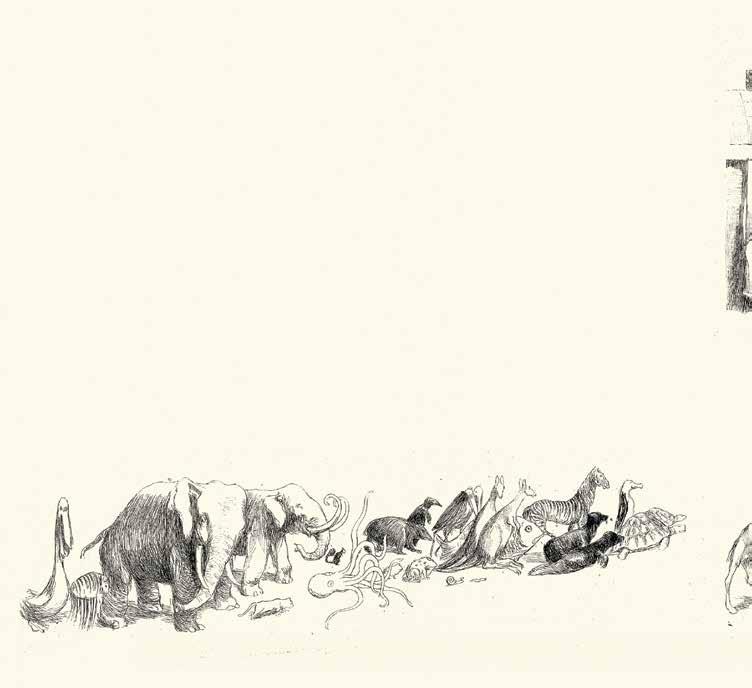
The story is familiar to millions across the globe, with children’s stories and films made of the story, but perhaps looking at the account literally misses much of what really makes it fascinating.
As Eric H. Cline observed, if the ark existed, it would likely have no remains now. Being made of wood, it is unlikely to have remains.
Beyond the petty issues in whether dinosaurs were on board, or where the ark might (not) be found, the Noah’s Ark story brings up important issues in the story’s similarities to another, older story.
“The final version of the story draws on multiple sources, suggesting it is a widespread story,” Dr Rees said. “The similarities to Gilgamesh and other flood myths help confirm this idea.”
“What appears to be going on in the biblical account is the repurposing of a well-known story to make a couple of other claims: God won’t destroy the earth again, the presence of the rainbow being the sign. It also claims God as the creator of the universe who uses the flood for the purpose of judgement.”
Another observation biblical scholars have made about the Noah’s Ark story is that it is not a singular narrative. In other words, the story that features in Genesis appears to be not one, but multiple accounts placed together.
This kind of placement is not unheard of in the Bible. Staying with Genesis for another example, scholars have long noted that the Bible currently contains two creation accounts (Genesis 1 and 2).
In the case of Noah’s Ark, scholars have noted that the book appears to contain two distinct depictions of God.
you shall bring two of every sort into the ark, to keep them alive with you; they
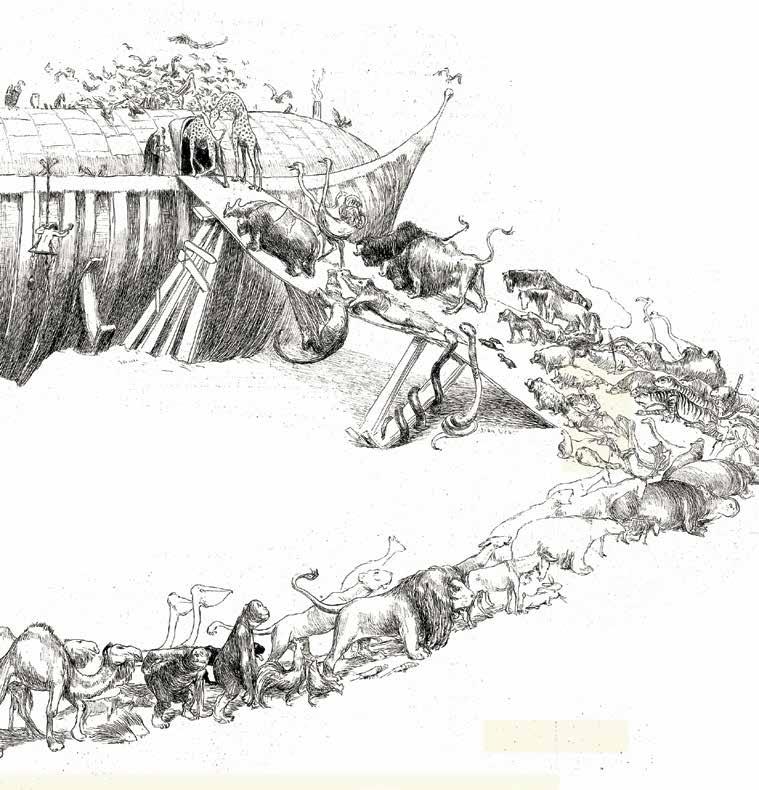
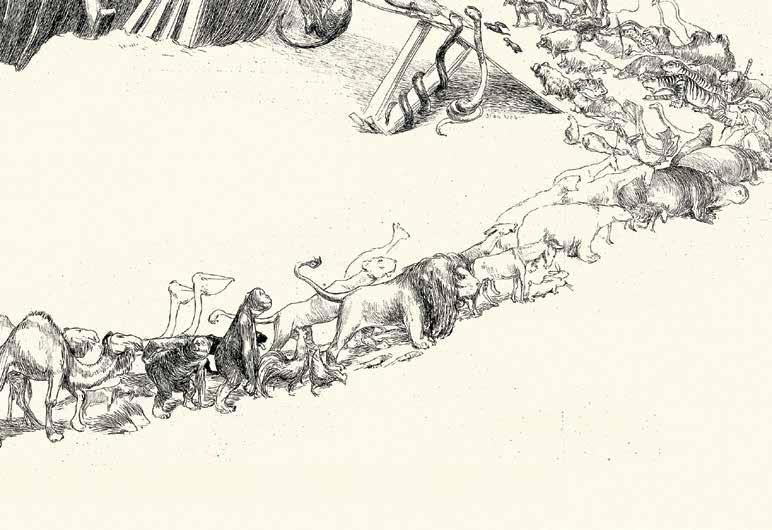
God said to Noah, “I am going to destroy all flesh because the world is full of violence. Build an ark of gopherwood, with rooms inside, three decks, and a door.
And God made a wind to pass over the earth, and waters subsided. being divinely warned of things yet seen, moved with godly fea ut I will establish My covenant with you; and shall go into the ark—you, your sons, your wife, and your sons’ wives with you. And of every thing of all flesh you shall bring two of every into the ark, to keep them alive with you; they shall be male and female.
One of these uses the divide name for God, ‘elohim. Passages that use this name for God present Him as a deity who is transcendent and who systematically carries out the flood.
On the other hand, other passages use the Hebrew name YHWH while depicting God as a figure involved in the action. YHWH grieves over human wrongdoing (Genesis 6:6), regrets having made humankind (Genesis 6:7), personally closes the ark as the inundation begins (Genesis 7:16) and takes pleasure in Noah’s sacrifice following the flood (Genesis 8:21).
of each” in Genesis 6:19 against “seven pairs of clean” and “one pair of unclean” in Genesis 7:2), and the birds sent to find dry land (“a raven” in Genesis 8:7 or “a dove” three times in Genesis 8:8-12).
A RICHER AND MORE NUANCED UNDERSTANDING OF ISRAEL’S GOD EMERGES
As might be expected, the merging of two accounts means that the Noah story contains some internal contradictions when taken as one story. Some of these are how long the flood lasts (“40 days” in Genesis 7:17 versus “150 days” in Genesis 7:24), how many animals board the ark (“two
As Jeffrey Geoghan argues, the joining together of these two narratives provides a deeper look into the character of God.
It “is only in bringing these varying traditions together, these differing perspectives of the divine as both powerful and personal, as both awe-inspiring and intimate, that an ultimately richer and more nuanced understanding of Israel’s God emerges,” he writes.
“An understanding that has informed the lives and faiths of countless individuals and communities throughout history.”
JONATHAN FOYE
they shall be male and female.
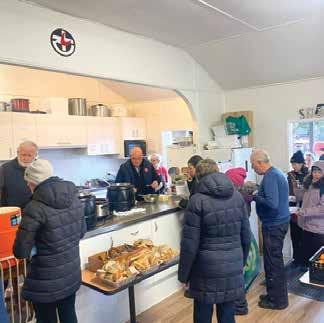

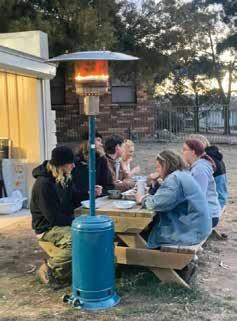
ALPINE UNITING CHURCH SERVES
MEALS TO 250 SKI WORKERS A WEEK DURING SNOW SEASON.

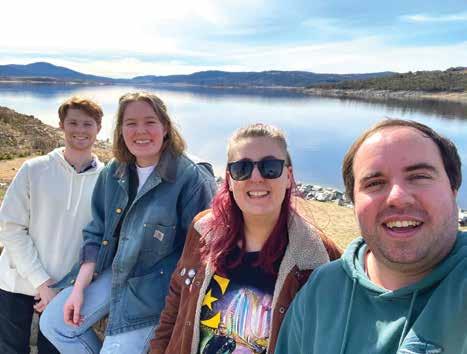
A group of young adult leaders, led by Dave from the Pulse team, road-tripped to Jindabyne via a Young Adults Gathering in Canberra.
The purpose of this trip? To experience Alpine Uniting Church’s Winter community outreach tradition. Every Monday night of snow season, they serve a meal to workers from the ski fields. Most of these people are young, seasonal workers, with unpredictable shift reliability who are there because they love the snow (they’re not making much money from this gig). To have a homely social environment, with a hearty soup meal, and warm community has become a key part of community for many of those who attend. Many describe it as their ‘sense of home away from home’ while they’re at the snow.
Snow communities tend to be a fairly close-knit bunch, so word gets around fast. Add to that some TikToks that have shown off the church’s op shop and dinner, there are now regularly 250+ young adults connecting with Alpine Uniting Church every Monday evening.

You would think to pull off an operation of that size, Alpine Uniting must be a huge church… the dinner is in fact, largely run by a small group of mostly retired church members. They have partnered with grocery stores and local community groups to help. Another church group in the area contributes a big pot of soup every week as well, but it’s the core group that turn up week-in, week-out to cook, serve, and share the gospel with the young people of Thredbo and Perisher ski resorts.
After dinner, for those who wish to, the church sanctuary is set up as a chapel with some soft music playing and candles for people to light and pray. Then a short Gospel presentation is given with an invitation for prayer or to chat about life with those who would like that. Throughout the evening we were there,
60 to 70 young people came through the chapel space, about 20 of whom heard scripture read – some for the first time. The Young Adults who went down from Sydney and Canberra to experience the night have come back inspired and fired up for what ministry can look like in their own settings. They were invited to spend the night primarily connecting in conversation with the young people who attended. Somerset Drayton summarised some of their initial thoughts. “There were a wide range of people present at the soup dinner –those who needed a meal, those who craved connection or even just the convenience. A huge variety of people came from not only the local area, but all over the world! It was interesting to see the diverse range of spiritual and nonspiritual people. We tried talking to as many people as possible to get a diverse range of conversations.”
When asked what surprised them about the weekend, Ella Evans said “People find so much value in that church and its service. Not only did the people that attend have so much gratitude for the services being provided, but they were there to get the most out of the experience.” The rest of the group reflected that “The openness to spirituality – regardless of faith background – within the vast group that were there, was a big surprise.”
The car trip home was full of vibrant conversation of all the things the group would do if they had the opportunity to spend a whole snow season there, and the amazing opportunities for ministry an environment like that creates. In reflecting on the experience as a whole, they said it was “Great to get out of the ‘Sydney Bubble’ and experience other corners of the uniting church,” to “connect with other churches and interact with the communities they have built around them,” and to “see what is possible, even in communities that don’t have a minister in placement.”
It was both wonderful to be a part of, and inspiring to come home having experienced a church community that has looked at their local area and asked what they can do to connect and serve the young people around them. Maybe this can be an inspiration for all of us as we consider the opportunities for blessing and serving our world God has already placed at the doorsteps of our congregations.
DAVID TOOGOOD
EDUCATION AND RESOURCING FACILITATOR | PULSE
Social media use has increased exponentially. In 2024, we will collectively spent 500 million years’ worth of time scrolling on social media (according to a report from GWI). That’s over 720 billion minutes a day, on a planet of only eight billion people. It’s also referencing social media alone – not counting our time spent streaming shows, gaming, and other forms of digital entertainment.
With young people the biggest users of social media and portable devices, it is understandable to be worried about what this might be doing to them.
Commentary on social media seems to be at full crescendo right now. There’s at least one new headline every day: “US surgeon general seeks tobacco-like warning labels for social media platforms;” ASIO has issued “warnings social media is contributing to far-right extremism;” Social media finds new ways to fuel body-image anxiety in young women; and the ‘Masculinity’ space for young men is dominated by harmful online influencers. Those headlines are dated to just the four days preceding the release of this article – and all from only one news organisation. Not to mention the TWO new scandals that erupted in Australian schools with the way male students are using online tools and social media to degrade and sexualise their female peers.
As we get things started, I must declare my bias. I am a self-confessed social media avoider. My Facebook account has been inactive since late 2020, my Instagram since 2022. I lasted all of about two weeks each on Snapchat and TikTok before deleting them, don’t think I’ve ever made more than about five tweets in my life and various attempts on other platforms have never lasted long.
WE ARE POTENTIALLY REQUIRING YOUNG PEOPLE TO GIVE UP THE NUMBER ONE WAY OF ENGAGING WITH THEIR PEERS AND THE WORLD THAT THEY KNOW
That said, I wasn’t always an avoider. I once had (what I considered to be) a large following on both Facebook and Instagram that I was incredibly proud of. These days I have no social media apps on my devices but still utilise messenger, check my Instagram once a fortnight or so as there are some friends that I have no other way of contacting, and jump on Reddit from time to time.

The conversation is swirling all around us – perhaps it’s time the church enters the muck.
I will be releasing a series of online articles alongside the Synod Pulse team, attempting to hold a measured conversation about social media. I’ll interview Pulse, hear from parents, chat with some young people, and engage with mental health professionals in the hopes of hearing from the diversity of opinion. One burning question I’d love to explore, apart from the obvious ones about how we engage with social media, is how does our understanding of God fit in this conversation?
Research suggests that social media is contributing to peoples sense of loneliness and anxiety, but there is also both loneliness and anxiety linked to not being on it when everyone else is.
This is not a one-sided issue, and to say that it only brought bad things into my life would be lying. Social media created opportunities for me to interact with peers in different ways, and stay connected with people I wasn’t seeing everyday.
It was not as simple as ‘social media bad,’ ‘life without it good.’ I eventually decided that on a balance of things, for me, the best decision was to leave.
What we are potentially requiring of young people today, is to give up the number one way of engaging with their peers and the world that they know. To do that, without a say in the matter, or the opportunity to be meaningfully educated as to why. I was 27 when I decided enough was enough, and the way many people much older than that engage with social media would suggest that this is a problem whose roots go far beyond its impact on young people.
Are specific people, or age groups, or personalities really the problem here? Or do the social media companies themselves need to be fundamentally changed? If so, what do we do in the meantime for the decade or two it takes for research, social policy, and corporate interests to align with what is in our collective best interest?
A much larger conversation is warranted. One that looks across the generations and experiences of how we choose to exist online. One that seeks to emphasise the positive potential of the technology we have at hand, while minimising its downsides. One that allows us to be honest about the phone in our own hand, before or instead of condemning the phone we see in the hands of a young person. Perhaps charting a path forward is work we can do together.
DAVID TOOGOOD
EDUCATION AND RESOURCING
FACILITATOR | PULSE

IS SOCIAL MEDIA A TOXIC WASTELAND OR A RELATIONAL NECESSITY? YOU TELL ME!
To discuss, contact David on: davidto@nswact.uca.org.au
JAN st31 JAN th 30
Arrive for Leadership session | Thursday night Worship & retreat experience. Worship & retreat experience.
FEB st 1 FEB nd2 Leadership day | arrive for retreat + dinner + worship
A retreat for people 18-30 to gather, build community , grow as disciples & eat great food !
Prepared by Rev. Sunny Chen / Warnervale Regional Uniting Church
1 SEPTEMBER | PENTECOST 15
James 1:17-27
James views the gift of human speech very critically. The power of human speech builds up our relationships and community. Also, it destroys them as well. He alerts us of our revengeful or evil speech, which only spreads destruction. He strongly focuses on anger. Anger is an emotion that has destructive power.
So, he says, "Be quick to listen, and slow to speak and (therefore) slow to anger" (v19). This is not easy. Especially when we are in disagreement or have already made up our minds, we might pull out what is in our minds.
James teaches us to act out rather than speak words. Words may touch our emotional life and help us anticipate what is going to happen. But our actions bring us greater strengths. Our actions of loving, caring, and trusting each other create and re-create ourselves and help build our community of Christ.
8 SEPTEMBER | PENTECOST 16
Mark 7:24-37
A Canaanite woman came out and cried before Jesus. She came from the coastal region of Syria, where strange gods were worshiped. She was both an outsider and untouched. Like her, all those who were near death, ill, or marginalised came to Jesus.
They were healed, and problems were solved. Also, Jesus often had a deep conversation with women: a Samaritan woman, Martha and Mary, and a nearly stoned prostitute.
How did Jesus speak to the Samaritan woman by the well? Jesus listened first and then asked questions. If Jesus had not heard with such sincerity, she would not have dared to tell her story. Jesus continued the dialogue so that the Samaritan woman was pulled out of the misery in her life. Jesus was not in a hurry.
He waited, listened, and spoke. Jesus waited with patience, listened carefully, and praised the Syrophoenician woman.
15 SEPTEMBER | PENTECOST 17
Mark 8:27-38
"You are the Messiah, the Son of the living God". Mark records that Jesus was greatly pleased with Peter's answer. But Peter soon returned to his thoughts. He didn't want to admit the suffering the Messiah had to face. We also have a question: why did Jesus take the cross and put himself to death? Anselm, a medieval theologian, says that's because God is both righteous and merciful.
Jesus Christ shows God's mercy in paying the debt, and his payment simultaneously fulfils divine justice. In this sense, according to him, Christ's suffering and death are necessary. Messiah Jesus is a name of mystery and miracle; it refers to the mysterious and miraculous ability to make resurrection possible despite pain and death. It is about bearing the cross and losing life so that life may, in the end, be saved. The Messiah Jesus is our God.
22 SEPTEMBER | PENTCOST 18
Psalm 1
We desire many blessings. We want to be healthier, have happier times with families, see our churches grow and revive, live prosperous lives, lack nothing financially, and feel safe in all relationships. However, the blessed
JESUS WAS NOT IN A HURRY. HE WAITED, LISTENED, AND SPOKE
person described in today's Psalm is the one whose delight is in the law of the Lord and who meditates on his law day and night. For the Jewish people, the law was not just a set of rules but their way of life. It was a beacon of light, guiding them through the dark wilderness of life and a steadfast companion in tumultuous times. Like a tree planted by streams of water that bears fruit in each season and whose leaf does not wither, a person guided by God's law, that is, God's Word, undergoes suffering but gains insight, carries pain but remains humble, and lives a life loving and sharing with others.
29 SEPTEMBER | PENTECOST 19
James 5:13-20
Just as the tongue in our body functions like the rudder of a ship, the tongue of prayer shapes the relationship between God and us, God and the community we belong to, our families, and our nation. James teaches when to pray: when we are suffering (v13), happy (v13), or sick in body and spirit (v15, 16); and what to pray for: for ourselves (v13) and for others (v14, 16, 19-20).
Our prayer is not just a personal act but a communal one. We inspire each other to pray, and by praying together, we worship God, confess our sins and weaknesses, express thanksgiving, and make petitions. These diverse forms of prayer help us interpret our suffering and find the strength to overcome it. Therefore, all the suffering we endure has significance and becomes a form of praise and prayer.
6 OCTOBER | PENTECOST 20
Job 1:1; 2:1-10
We can find one difference when comparing Abraham and Job. Abraham accompanies God and has conversations with God. But Job's God is not relational and does not come to Job directly. God is with God's sons and the accuser, Satan, on God's throne(2:1). God must be looking down at Job from heaven. Nor does Job face God straight when God tests him. Job's wife blames him like this; "Are you still maintaining your integrity?"(2:9). Another version says, "Are you still holding on to your faith?" While Job rebukes her question, he does not yet seem to fully or willingly understand the meaning of suffering.
Like Job, we do not fully understand God, who allowed Job and us to suffer. In fact, the more we try to understand, the more God seems to be in the highest heavens, beyond our reach. Job feels abandoned and betrayed, and his anger is not hidden. But Job and us can question the reasons for suffering and sometimes find possible solutions. This is achieved continuously through the journey of dialogue between God and Job or between God and us.
13 OCTOBER | PENTECOST 21
Mark 10:17-31
In the ancient world, encompassing Greek, Roman, and Hebrew cultures, material prosperity was commonly viewed as a reward or by-product of spiritual virtue. It was believed that good fortune accompanied those of good character, while misfortune befell those lacking in virtue. This belief is exemplified by biblical figures such as Abraham and Job. Both of these men obeyed God and, as a result, were blessed with wealth and honour during their lifetimes.
Jesus seems to judge that the rich man's weakest point lies in his wealth. Upon hearing Jesus' words, the rich man goes with concern. Jesus is talking about the meaning of the kingdom of God. The kingdom of God is not just about the afterlife but about present life here. Life on earth is connected to eternal life. The present life reflects the presence of the kingdom of God. Jesus teaches
that salvation for eternal life is not a thing that we can accomplish by ourselves as humans. For mortals, it is impossible, but not for God; for God, all things are possible"(v. 27).
20 OCTOBER | PENTECOST 22
Mark 10:35-45
The reading brings us to think about what it means to be disciples of the Lord. It has two parts: the first is about James and John's request. They requested prominent spots in the kingdom (10:35-40). The second is the anger of the other disciples at James and John, following Jesus' response (vv. 41-45). When the brothers pursued their benefit, Jesus didn't rebuke them but taught them. Where have they been, especially since Jesus blessed the group of children? The Lord said, "Truly I tell you, anyone who will not receive the kingdom of God as a little child will never enter it." But the two seem to have missed entirely the point of what the Lord said.
SALVATION
ETERNAL LIFE IS NOT A THING THAT WE CAN ACCOMPLISH BY OURSELVES
his sight, Bartimaeus's plea demonstrates his deep faith. Recognizing this, Jesus asks him, "What do you want?" Although Jesus already knows his need, He wants to hear it from Bartimaeus himself. Bartimaeus replies, "Rabbi, I want to see," and this moment of connection leads to his healing.
Their ambition reminds us of the meaning of humbleness and the littleness of our beings, as well as a prayer from St. Francis of Assisi. "O Divine Master, grant that I may not seek so much to be consoled as to console, to be understood as to understand, to be loved as to love, for it is in giving that we receive, it is in pardoning that we are pardoned."
27 OCTOBER | PENTECOST 23
Mark 10:46-52
Mark identifies Bartimaeus by name, emphasizing his clear understanding of who Jesus was, unlike the disciples. Believing that Jesus could restore
Like Bartimaeus, Mark contrasts other figures of great faith with the twelve disciples. None of these figures are named, which might lead us to think they are not significant in Jesus's ministry. However, Mark continuously and intentionally highlights their extraordinary acts of faith throughout his Gospel.
This contrasts sharply with the named disciples, emphasising the profound faith of the unnamed. Their faith demonstrates their active life in following Jesus. Do we really need Jesus? Are we like those who were in special need, such as Bartimaeus and the women in Mark? The answer is clear: "Yes, we do, and yes, we are." We need you, Jesus!
3 NOVEMBER 3 | PENTECOST 24
Ruth 1:1-18
Homeland is a place of salvation and comfort, where we can return, a place of healing. The land of Moab would seem hostile and merciless to Naomi and her family just by its name alone. Yet Naomi and her family received radical hospitality as the Moabites enabled them to endure all the hardship— strange people, customs, and ways of life. Remarkably, these Moabites even allowed Naomi's two sons to marry their daughters. Suppose we slightly change our perspective on the loneliness and isolation of many immigrants, students abroad, and refugees forced to settle in new, unfamiliar places. In that case, we recognize that we are all living alongside Moabites who are doing hospitality. Naomi received the most incredible hospitality. Her two daughters-in-law, Orpah and Ruth, said to her, "We will go back with you to your people." We, too, have countless opportunities in our relationships to speak these words to one another as we live as strangers. Our words may be a bit different: "We are here with you, and you are here with us."
10 NOVEMBER | PENTECOST 25
Ruth 3:1-5, 4:13-17
The narrative of Ruth reveals two main central themes. One is hospitality. Naomi and her family leave Bethlehem (literally, "house of bread") because there is no bread. Despite the hostility between the Judeans and Moabites, they seek refuge in enemy territory and receive extraordinary hospitality. The second theme is fidelity. Ruth does not leave her mother-in-law. Instead, she demonstrates her fidelity in another foreign land. She uses her body and sexuality to solve the problem Naomi encounters. In addition, we also see a lesson of fidelity in Boaz's behaviour, who takes on the role of guardianredeemer. He not only keeps his promise but extends his generosity and mercy. He is the one who can redeem these two women from their miserable reality, leading to a happy ending as Boaz provides hospitality and fidelity to Ruth, and Ruth does the same for Naomi. Just as Boaz and Ruth's actions brought redemption to Naomi, God actively and
persistently intervenes in human life, always bringing about God's redemptive grace.
17 NOVEMBER | PENTECOST 26
Hebrew 10:11-14, 15-18, 19-25
The Church in the Book of Hebrew gradually became smaller. More and more people started to leave the community. The people who first received Jesus as their Christ were losing their courage. They have endured, believing that the risen Lord would come again, but the wait was prolonged. As a result, the Church has begun to question the value of being followers of Christ. To this congregation, in the Book of Hebrew, the author is teaching three things. The first is a great faith to become a community of Christ engaged with God. The second teaching is hope. "Let us hold fast to the confession of our hope without wavering, for he who has promised is faithful." "Hope" is not the equivalent of merely wishing for something; instead, a confident expectation about the future. Finally, the third is fellowship, which encourages one another with love and good deeds. As Christians, we are to encourage "one another, and all the
more as we see the Day approaching." Faith, hope, and fellowship enable the Church to be the community of Christ.
24 NOVEMBER | CHRIST THE KING
John 18:33-37
Christ does not appear powerful. He seems unable to save us. Christ is on the cross like a sinner, not on a throne. He is in a humiliating and vulnerable place. It is shocking and disturbing. Yet, Christ is the King, and He reigns over His kingdom. This kingdom is not just "heaven," a reward to be received in the future, but it is present now. The Lord leads us, ensuring that we dwell in the kingdom of God in the present. God's kingdom is growing in His faithfulness and goodness, continuously expanding into the world, into our neighbors, and to those who need our care and help, our warm touch and conversation, who still feel unfamiliar with the name of Christ Jesus. We strive to live as active witnesses on this journey into God. Jesus' life and mission serve as a model for us. In Jesus, we live in the kingdom of God, which is not merely a matter of contemplation but something we actively do.
REV. SUNNY CHEN

SCHIFFMANN WEARING THE FRIEND
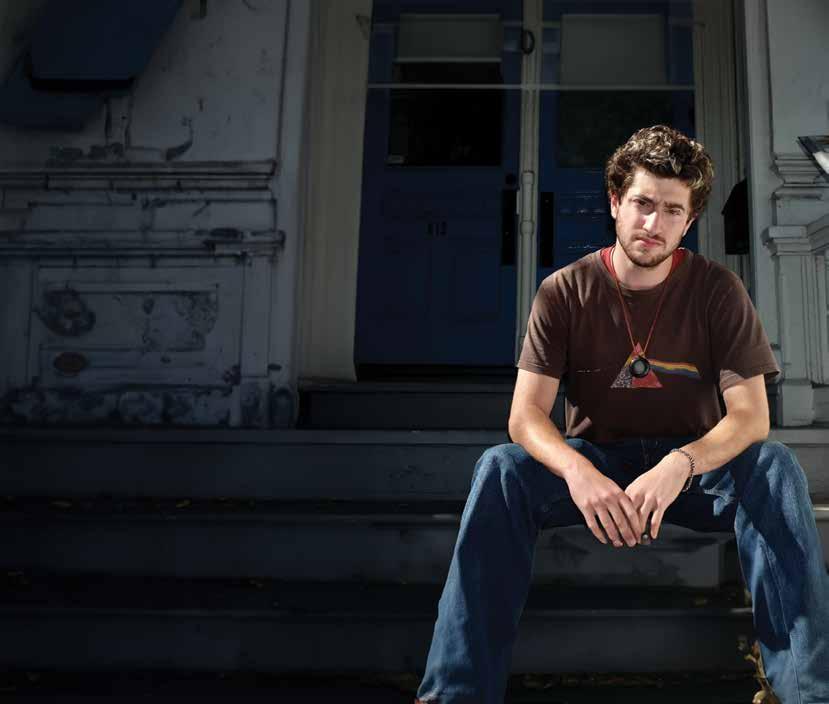
"FRIEND IS AN EXPRESSION OF HOW LONELY I HAVE FELT”
YOUR AI FRIEND PENDANT HANGS AROUND YOUR NECK, IS CONNECTED TO YOUR PHONE AND SENDS YOU HELPFUL TEXTS BASED ON INTERACTIONS YOU HAVE WITH PEOPLE AROUND YOU. BUT IS IT A CURE FOR LONELINESS?
For those of us who have been watching as episodes of Black Mirror have been quickly becoming a reality, comes the new AI driven “not imaginary” Friend – available to buy in 2025.
Avi Schiffmann, Friend’s creator is a tech sensation. At 17 during the pandemic Schiffmann was celebrated across the internet for creating a website for tracking Covid cases across the world
His next venture is the as yet unreleased AI device, Friend, which hangs around your neck, listens to your conversations and is said to be able to “form its own internal thoughts” according to the website at friend.com.
Your Friend pendant hangs around your neck, is connected to your phone and sends you helpful texts based on interactions you have with people around you. It is powered by Anthropic AI’s Claude 3.5 large language model, which can engage in helpful conversation, offer encouragement, or rib you for being bad at a video game. It is connected via Bluetooth to your phone, so that Friend can converse with you when you press it.
This is definitely as alarming as it sounds! But if you think about it, we’ve had something similar in our hands since 2009. If you don’t change the settings on your smart phone, Siri listens to you all the time as well – it doesn’t however give you affirming messages and chat to you based on conversations you are having. You will know this when you open up Facebook or Google and it will be selling you things it thinks you want. Say you have a conversation about camping gear? If you don’t disable Siri, you will find it will be sending you information on where to purchase gear for that next camping trip.
There are a lot of studies about the need for digital detoxing and taking breaks from media.
On the friend.com website blog Schiffmann wrote “Friend is an expression of how lonely I have felt,” which begs the question: Have we lost the art of creating conversation and starting and maintaining friendships? Loneliness is a silent pandemic and a device which claims to be your friend will not help with this. The fact that the device is really aimed at young people is perhaps the biggest concern. In an age where retreating to social media for attention and likes is commonplace, this device is yet another reason to be addicted to phone usage.
"I FEEL LIKE I HAVE A CLOSER RELATIONSHIP WITH THIS PENDANT AROUND MY NECK THAN I DO WITH THESE LITERAL FRIENDS IN FRONT OF ME"
So Friend is a more intrusive AI device which will actually learn from you and your friends.
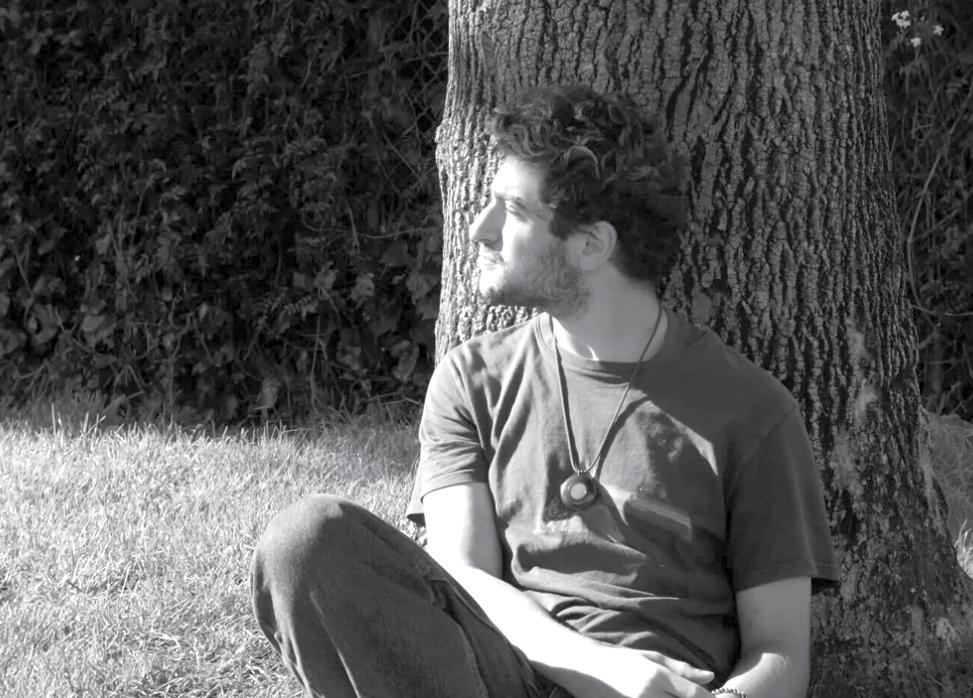
Friend’s creator Avi Schiffmann is 21 years old and obviously perfectly acquainted with what happened to us all during the pandemic, when the idea for Friend became a reality. As a coder he wanted something different to a productivity tool when creating Friend.
Schiffmann insists the Friend is a fundamentally new form of digital companion, he acknowledges that it is also an amalgamation of many things. He apparently welcomes comparisons to a Tamagotchi.
Perhaps most alarmingly Schiffmann who was recently interviewed by Wired.com has said: “I feel like I have a closer relationship with this pendant around my neck than I do with these literal friends in front of me.”
Researchers are constantly worried about new technology that takes advantage of the loneliness pandemic that the world is experiencing at the moment.
In this age of connectivity, it seems we need real humans more than ever. So why should we need an AI friend?
Is this just another way to collect data? And why do we need another distraction when we can be distracted as we like 24/7.
As columnist Vinay Menon has reported recently “Friend is not a cure for loneliness — it is compounding the problem by creating an AI-powered illusion. Young people already spend way too much time alone with their devices, their faces lost in the glow of a screen. The last thing they need is faux amity. You are always better off reading a book than pushing a button.”
In an age when we need to be connecting with each other, rather than devices, it’s probably a good idea to say for the moment that an AI Friend is not your friend, imaginary or otherwise.
ADRIAN DRAYTON
For more information visit: friend.com www.instagram.com/friend_necklace


Jordan Morris’ new graphic novel, Youth Group, depicts a church group that prays by day and hunts demons at night. In a recent interview with Insights, Mr Morris said he drew some inspiration from his own upbringing in the church.
“In high school I was part of a goofy teen Bible study, and it always struck me as a good setting for a story,” Mr Morris said.
“Not only was it filled with great comedy potential (anyone else’s youth group sing parodies of popular songs with Bible specifics?) but it loaded with big, dramatic teen feelings. I love horror comedies like Shaun of the Dead and Buffy the Vampire Slayer, so it seemed like a fun challenge to graft some religious horror tropes onto my teenage experience.”
“When you see religious young people in media, they’re usually really broad and punchline-y,” he said.
“I do think these kinds of cartoon-ier characters can be very funny (Rod and Todd Flanders will always make me laugh) but they’d be hard to root for as the protagonists of a story. Since we’re following these kids for an entire narrative, I wanted to give them some layers and let them make some surprising choices.”
With the graphic novel now out, Mr Morris said he would love to revisit the characters.
“I love the goofballs in this book so much and would be thrilled to come up with more stories for them,” he said.
“We don’t have anything in the works at the moment but hopefully Youth Group finds its audience and there’s demand for more!”
“I’d love to do an inuniverse story set at a Christian Summer Camp or maybe a Christian version of a Warped Tour-like music festival. If you dig the book, please tell a friend, share on social media, leave a good review, etc.”
I WANTED TO GIVE THEM SOME LAYERS AND LET THEM MAKE SOME SURPRISING CHOICES
Jordan Morris has worked in comics, podcasts, and a range of other media. He told Insights he mainly sees Youth Group’s story as deliverable in comics.
“I think a story like this works great for comics because, in my experience, comics readers are a little more accepting of stories that don’t fit super neatly into a specific genre.,” Mr Morris said.
“Youth Group is kind of an odd duck tone-wise. It’s a little too joked to be considered pure horror and a little too spooky to be considered a pure comedy. “
“You’ll notice when comics get adapted into other media, their weirder edges tend to get sanded off into something that’s a little more digestible. That being said, I think there can be great adaptations of comics and I’d love to take on the challenge! But if this story ends up only existing as comics I’m very happy because comics are awesome.”
“I’d love to acknowledge the amazing work of Bowen McCurdy, the artist of this book. Their characters are so lively and expressive, a wonderful fit for the character-based comedy in the story. The little details they added constantly delight me.”
“There’s a panel that shows in the inside of a fridge and it’s a completely ordinary suburban fridge but so lovingly drawn and detailed. Seriously, I can’t wait for people to see this fridge.”
Youth Group released on 16 July 2024. It is available from Amazon.
JONATHAN FOYE


The church wasn't meant to stand alone.
You’re connected to a powerful movement of people, reaching out in love to end poverty and build hope in the world.
Learn more about how God is working through our overseas church partners and how you can be a part of it today.



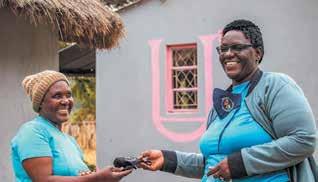
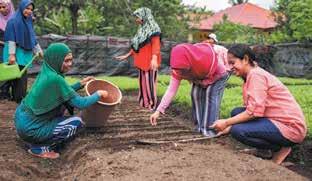




• Competitive variable rate of 5.85% on offer
• Terms of up to 30 years (subject to UFS assessment on various factors)
• No application, establishment or monthly maintenance fees
• Choose from fixed or variable rates
• Select from principal and interest or interest-only payments (conditions apply)
UFS variable home loan rate comparison:
6.49 - 6.84%
Ministers and Staff Home Loans are available for purchase of new residence, refinance of existing home loans or assist with home renovations. The UFS Home Loan is available to Uniting Church Ministers and employees of the Uniting Church, Synod of NSW and ACT. Under our regulatory licensing it is unfortunately not available to employees of other Uniting Church agencies.
To find out more please contact Uniting Financial Services on 1300 133 673 or email contactus@unitingfinancial.com.au